Get ready for the eye-popping colors of autumn that are taking over Aberdeen


34 PARKS & REC + SICA HOLLOW + SALESI & MELE MOUNGA + SPORTSCASTERS SEPTEMBER/OCTOBER 2018
Fall Shades
FEATURES
18 ARTFULLY ADORNED Senior goldsmith, silversmith, and artist Cherise Mayer talks about finding her medium and putting her work out into the art world.
20 A STORY OF FAMILY AND FAITH
On their 20th wedding anniversary, Salesi and Mele Mounga reflect on what they are most proud of in their life together, and on how Aberdeen became their home.
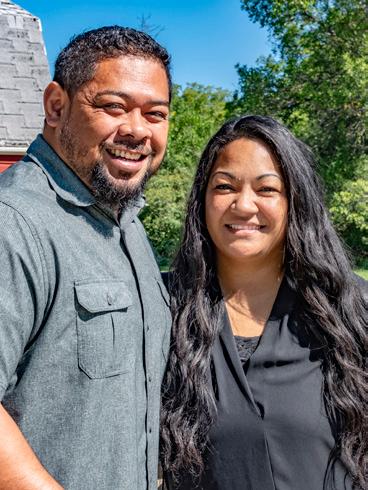
24 AIMING FOR THE FUTURE
Outdoor opportunities are everywhere in the Aberdeen area, thanks to people like the Great Plains Outdoorsmen who dedicate their time to preserving them.
32 VOICES OF ABERDEEN
They connect sports to the fans and get to be a part of each and every game. Hear from some of the Aberdeen sportscasters who have brought you all the play-by-play action of your favorite area teams.

36 THE HUB OF ACTIVITY
No matter the season, Aberdonians are turning to the Parks, Recreation & Forestry Department to find things to do. Luckily, department leaders David Eckert, Doug Johnson, and Gene Morsching have got us covered.
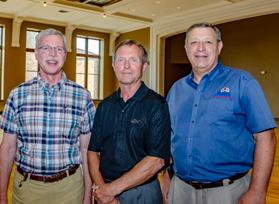
40 FALL HAUNTS

Sica Hollow State Park is an unusually dense forest in the middle of an otherwise open plain, making it a great destination for viewing the changing leaves, and maybe for uncovering some urban legends too.
44 BRILLIANT & BEAUTIFUL
Fall in love with the vibrant fashion trends found at Boho Closet Boutique.
48 MAKE OR BREAK BEFORE A STATE
Brown County is sprinkled with small towns that surround Aberdeen, the Hub. We’re going back to the 1880s to find out how these rural communities got their start.
54 LIVING IN THE PAST
See the unique piece of Hub City history that Mark and Cherie Shishnia uncovered during a renovation of their Aberdeen home.
55 FITNESS APPS THAT MOTIVATE
Advice from the Aberdeen Family YMCA on using technology for a healthy lifestyle.
28 PULLING OUT ALL THE STOPS
1,888 pipes will be joining in the worship at Sacred Heart Church as the parish adds a new, exquisitely handcrafted organ.
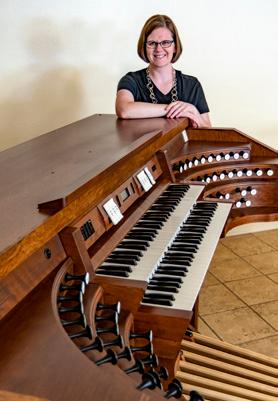
ON THE COVER
Model Jadyn Brandon shines in a jumpsuit, ’80s inspired earrings, and lavender fedora from the Boho Closet Boutique (see story on page 44). Photograph by Christina Shilman of Paisley Tree Photography.


REGULARS 04 FROM THE EDITOR 06 THE HUB Your source for what’s happening in Aberdeen. 14 CALENDAR Never miss an event in the Hub City. 16 RECIPE: PUMPKIN PECAN BARS All the flavors of homemade pie ignite in this decadent dessert that has two dreamy layers of pumpkin spice and caramel pecans. VOLUME 6 ISSUE 5 ABERDEENMAG.COM September/October
2018
PARKS & REC SICA HOLLOW SALESI & MELE MOUNGA SPORTSCASTERS SEPTEMBER/OCTOBER 2018
Get ready for the eye-popping colors of autumn that are taking over Aberdeen
Fall Shades
20 16
28 32 36 2 ABERDEEN MAGAZINE september/october 2018
ISSN 2378-3060
What was your favorite holiday as a kid? Opening weekend for pheasant hunting was mine. No seriously, it was! As adults, my brothers, cousins, and I have discussed at length how we saw more extended family over opening weekend than during any other time of the year. And when else could you spend the whole day outside with your dad, uncles, and their friends, walking through fields and eating pickled watermelon, tiger meat, and potato sausage wrapped in cabbage for breakfast, lunch, and dinner? After I passed the hunter’s safety course at age 12, my great-uncle bought me a shotgun, but I was only a real hunter for a short time. Now, the best part of opening weekend for me is spending it with my mom, aunts, and daughters while everyone else is out searching for birds.
But I still love the outdoors, and maybe that’s because of all the time I spent in it as a kid. In this issue, we’re featuring the Great Plains Outdoorsmen, a group of 22 volunteers who host one of the biggest sportsmen banquets in the region, and have donated nearly $1 million dollars to local outdoor programs, all so more area youth (and adults) have opportunities to get outside. On these pages you’ll also get to know some of the leaders at the Aberdeen Parks, Recreation, and Forestry Department, who make it possible for the Hub City to have fun outdoor (and indoor) activities all year long. We’ll also meet senior goldsmith and artist Cherise Mayer, whose work is inspired by the South Dakota outdoors.
When you live in a place with four distinct seasons, you feel the change from the long days of summer to the crisp fresh-starts of fall down to your bones. To usher in this beautiful time of year, check out our autumn road trip guide to the nearby Sica Hollow State Park. If you still can’t get enough of those orange and red hues, turn to our fashion photo shoot featuring the Boho Closet Boutique for stunning shades that rival any of those made by Mother Nature.
Finally, it wouldn’t be September and October without the return of fall sports. Play-by-play sportscasters bring all the best-loved games and plays into the living rooms of fans everywhere. Be sure and take a look at our story on the voices, both past and present, that capture the Aberdeen area sports scene.
At Aberdeen Magazine, we’re wishing you all a very happy fall!
Jenny Roth,
MANAGING EDITOR
MIKE MCCAFFERTY is an avid historian, accomplished writer, professional fisherman, and trainer. His passion is Great Plains history, and he currently serves as a member of the Dacotah Prairie Museum Board. Mike has had over 200 articles printed in outdoor magazines throughout the Midwest and Canada.


MANAGING EDITOR
Jenny Roth

PUBLISHER
Troy McQuillen
DESIGN
Eliot Lucas
AD SALES
Abby McQuillen abby@mcquillencreative.com



PUBLICATION OFFICE
McQuillen Creative Group 423 S. Main St., Suite 1 Aberdeen SD, 57401 (605) 226-3481
PRINTING
Midstates Printing
SUBMISSIONS
Aberdeen Magazine welcomes your input. Message us your story ideas, drop off historic photos, or stop in for a chat. Email us at: troy@mcquillencreative.com
WEBSITE www.aberdeenmag.com
PRIVACY STATEMENT
Any personal information, email addresses, or contact submitted to the editorial office or online via our Facebook page will not be sold or distributed. Aberdeen Magazine does wish to publish public comments and attitudes regarding Aberdeen, therefore written submissions and comments on our Facebook page implies permission to utilize said information in editorial content.
TARA SCHIPKE has been cooking in restaurants for 14 years. She is currently the assistant manager at Minerva’s Restaurant and Bar and a custom pastry and dessert chef. Her passion for cooking started at home with parents who were great cooks and encouraged learning in the kitchen. In 2012, she graduated with honors from Le Cordon Bleu in Minneapolis.
Aberdeen Magazine is produced exclusively in Aberdeen, South Dakota. All content is copyright with all rights reserved. No content may be shared, copied, scanned, or posted online without permission. Please just ask us first. We’re pretty flexible.
www.mcquillencreative.com
FROM THE EDITOR
PATRICK GALLAGHER is a regular contributor commenting on Aberdeen’s personality, food options, and history.
VOLUME 6 • ISSUE 5 • SEPT/OCT 2018
THIS ISSUE ’ S CONTRIBUTORS
CHRISTINA SHILMAN is a wife, mom to an amazing baby boy, mental health therapist, and owner of Paisley Tree Photography. Her photography business opened in 2013, and specializes in weddings, seniors, families, children, and lifestyle sessions. She loves capturing authentic and unforgettable moments for her clients.
4 ABERDEEN MAGAZINE september/october 2018
ERIN COATS graduated from NSU with degrees in fitness management and business marketing, and earned her personal trainer certification from the National Strength & Conditioning Association. She is the wellness coordinator at the Aberdeen Family YMCA, where she spends her days helping people become stronger, healthier, and more confident. Besides fitness, her greatest joys are being a mom, spending time with her family, and being outdoors.
THE hub
CARRY YOUR ESSENTIALS IN STYLE
Lily’s Floral and Design is welcoming the return of Vera Bradley products to their store. The design company is known for their colorful purses, bags, and travel accessories for women that are as bright and beautiful as they are functional.

Lily’s will carry a wide selection of the brand, including cosmetic, duffel, and travel bags, along with zip ID cases and lanyards, all in the season’s newest patterns and prints. If there’s a specific Vera Bradley item that you want and they don’t have it in store, they can easily order it in for you. Owner Pam Teigan adds, “Their products make great gifts anytime of the year.” // — Jenny Roth
FOR THE LOVE OF FILM
A former assistant technician with the Aberdeen Community Theatre, Charlotte Grandpre says she has always had a heart for films, but making one wasn’t something she thought she could do. “I thought you had to have this huge team with fancy equipment or a degree in filmmaking, and I had none of that.” What she did have was a story. “Right when I walked on stage for the first time at ACT, it just hit me that this would be the most beautiful place and most beautiful story to put in a film, simply because of all the connections that have been made at the theatre, and the history of the building itself.” When the ABDN DOCS short documentary competition was announced this past spring, she decided it was the right time to try making her ACT film. “I just loved this story so much that I decided to go for it.”

Charlotte filmed all the footage for her mini documentary, titled Your Community Theatre, using her iPhone. Other than help with a drone shot and some of the mixing, she put the film together entirely on her own. Through the process, she discovered that she really liked talking to people, learning things about them, and sharing their stories. This realization prompted her to launch Tribute Films, her new business that produces cinematic documentaries and films for nonprofits, businesses, and individuals in Aberdeen and throughout the region. She says her films are different than commercials in that they focus on the core of the business, and getting to know the people in our communities.
While she will continue to volunteer at ACT, Charlotte is now dedicated to telling stories through Tribute Films full-time. About her new venture, she concludes, “It’s for anyone who has a story to share. Everybody’s story is important, and there’s somebody who needs to hear it.” // —
Jenny Roth
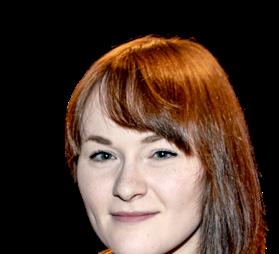
For more information on Tribute Films, visit www.facebook.com/TributeFilmsSD.
Lily’s Floral and Design, 423 S Main St., is open from 9:00 AM to 5:30 PM Monday through Friday and 10:00 AM to 4:00 PM on Saturdays. For more information, call 605-725-5459.
YOUR SOURCE FOR WHAT’S HAPPENING IN ABERDEEN
Charlotte Grandpre recently began making cinematic documentaries via her new business, Tribute Films.
6 ABERDEEN MAGAZINE september/october 2018
Photos by Troy McQuillen
BEAUTY THAT GLOWS
Driving down Sixth Avenue, something new might have caught your eye. A flowery sign reading “Catching Fireflies Boutique” has been stealing the attention of Aberdonians. The masterminds behind Aberdeen’s latest fashion stop are Gina Sommers and DeAnna Hauge. The two rural ladies began as longtime friends, and now recognize one another as business partners. Both felt ready for a change in their lives, so they decided to establish their own boutique. A shared love for fashion and making people feel good inspired them to provide boutique clothing that everyone could afford. What began as an online business, soon expanded to a storefront due to request and high demand. “Try it! If you have a dream you have to chase it,” Gina advises aspiring entrepreneurs.
Catching Fireflies is set apart from other boutiques in that everything is $39 or less, and that they offer sizes newborn3XL. Gina and DeAnna wish to clarify that they are not a consignment store! Despite common misconception, all of the store’s clothing is new. They also want to thank their customers for all the support. “We appreciate it beyond what words can express.” // — Mary
 Elizabeth Wachs
Elizabeth Wachs
Catching Fireflies Boutique is open Tuesday through Saturday from 11:00 AM to 4:00 PM, with extended hours Wednesday and Thursday from 11:00 AM to 6:00 PM. Free delivery is available for anyone in town, and free shipping is provided for online shoppers spending over $75. For more information, visit www.catchingfirefliesboutique.com
YOUR CUE ON WHERE TO PLAY POOL THIS FALL
Members of the Aberdeen Cue Club come from different walks of life, but they all have at least two things in common: they all love pool, and they’re all trying to get a little bit better at it. Club President Charlie Gould explains, “Everyone knows it’s more fun to be more accomplished at any sport or activity. We’re all trying to increase our skills.”
The club is currently at 1603 6th Ave SW, their third location since forming about six years ago. Around 30 members have access to the building’s five tables anytime they want to play pool. “We have guys who have odd shifts, and they’ll come here in the morning or even in the middle of the night when they get off work,” Charlie says. Throughout the year, especially in the fall and winter months, they’ll get together at scheduled times and have games or mini tournaments for members and nonmembers alike.
Along with being able to play pool at all hours, members of the Cue Club also get to enjoy using a facility that’s in good shape. Charlie adds, “We really stress

keeping our tables and everything in topnotch condition. It’s just more fun to play somewhere that has good equipment.”
There are at least three official pool leagues in Aberdeen, and most Cue Club members play on one or more of them. Their club membership gives them that added opportunity to get in more practice. Plus, it’s affordable. “It’s cheaper than going to the bars to play or buying your own pool table,” Charlie says. To join, new members pay a $25 initiation fee, and then $25 per month after that.
Some club members are in their 20s, and others, like Charlie, picked the sport back up in their retirement years. He says that what they all like the most about pool is meeting other players. “A lot of our members go to tournaments all over, and you meet so many people at those, and most of them are just really easy to get along with. It’s the going places, meeting people, and playing that we love-and the competition part of it is what encourages you to keep getting better.” Hence, the Cue Club. A place to improve your game, and meet friends. // —
Jenny Roth
For information on joining the Aberdeen Cue Club, call Charlie Gould at 605-380-4999.
BUZZ
DeAnna Hauge and Gina Sommers offer clothing in sizes newborn to 3XL at Catching Fireflies Boutique.
Photos by Troy McQuillen
8 ABERDEEN MAGAZINE september/october 2018
Aberdeen Cue Club members have access to the club’s five pool tables 24 hours a day, seven days a week.
GROWING UP WITH FUNDAMENTALS
While working as a pediatric physical therapist and becoming a new mom herself, Mikala Simon heard a recurring theme in many conversations among parents and caregivers: toys! “Being around so many families at work and in my personal life, I realized we were all going through the same thing in comparing toys and trying to find the best ones,” she explains.
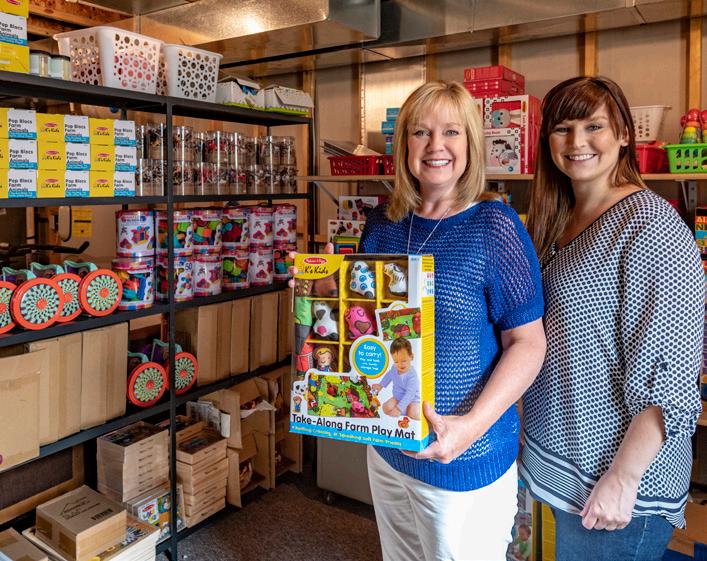
Physical therapists often use toys and play to help kids reach developmental milestones. Mikala knew her knowledge about which toys worked best for each different stage of a child’s life would be beneficial to many parents. So this summer, she and her mother Bonny Merxbauer launched Stages of FUNdamentals, their online business that sends out boxes of carefully selected toys, activities, and books for children ages birth to five years.
The items in each FUNdamentals box are meant to help all children grow and learn through play. They show families how to have fun together while their children are also developing important gross motor, fine motor, speech, and cognition skills. Along with the toys, Mikala says they also provide education and instructions on how to use them for every stage. “For example, if we send blocks in the 12-18 month box, we’ll also give you ideas for different games you can do with them. And you can still play with those blocks even when your child is two or three years old, so we’ll give you tips on how to use them in the years ahead too.”
Since infants grow and change so much, during their first year a new Stages of FUNdamentals box is sent out every other month. After their first birthday, they’ll receive a box of new toys and instructions every six months. Mikala and Bonny take orders and package boxes out of their homes in Aberdeen. They can ship them both locally and nationwide.
And Mikala adds that their subscription boxes aren’t just for new parents. “My mom has six grandkids, so she brings that unique vision on how we can make these accessible for everyone. We want grandparents and caregivers to be able to use these toys too.” // — Jenny Roth
To learn more about Stages of FUNdamentals, find them on Facebook, Instagram, and Pinterest, or visit www.stagesoffun.com.
RINGNECK RIDGE HOPES TO EXPAND ABERDEEN’S WEST SIDE
Bath-area farmer, Jarrett Jones, is building a new commercial and housing development in Aberdeen and naming it after South Dakota’s signature bird.
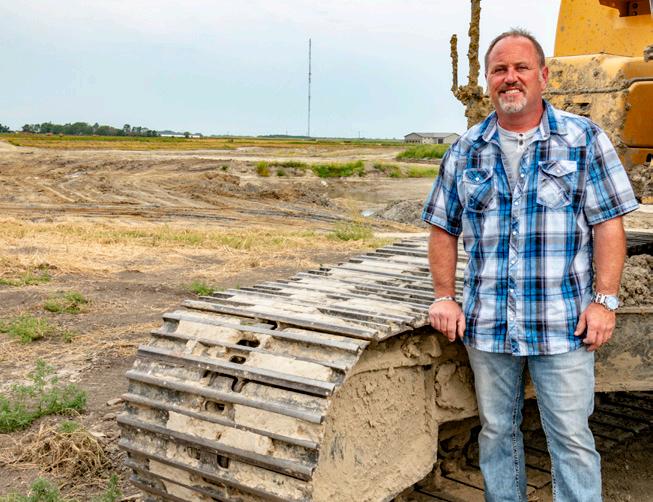
Ringneck Ridge Development is located just west of Rolling Hills next to the Highway 281 bypass. It includes a total of nearly 150 acres, 24 of which are frontage lots devoted to commercial use. As of yet there aren’t confirmed details on the specific types of businesses going in, but Jarrett says when talking to people the thing asked for the most on Aberdeen’s west side is a grocery store. For housing, Ringneck Ridge has space for about 150 homes, with 55 lots becoming available during the initial building phase. About 18 lots will also be set aside for premier housing on the development’s 14 acre manmade Gooseneck Lake. Right now they are in phase one of the three-phase project, and busy working on the roads and sewer and water systems. Jarrett says, “By fall we’ll be close to where people can start digging basements for winter build, and by spring we’ll have the utilities in and be ready to roll.”
Its location, and some special features throughout, make the development unique. There aren’t a lot of other opportunities on Aberdeen’s west side for new development, and Jarrett adds, “Elevation here is higher than most places, so there’s no floodplains or water issues. There’s also good traffic from the bypass, and the area is still more of a rural setting.” The lots in Ringneck Ridge will be larger in size, and the roads and key points in the development are all named with a hunting and outdoors theme.
This is Jarrett’s first commercial and housing development. Previously, he has put up a campground, built and flipped homes, and taken on other similar endeavors. He also owns a dirtwork company, which is doing a lot of the dirt work for the Ringneck Ridge project. “I like the idea of development and doing something new and different for Aberdeen,” he says. // — Jenny Roth
BUZZ
Photo by Troy McQuillen
Photo by Stephanie Ludens
Mother and daughter team Bonny Merxbauer and Mikala Simon recently launched a home-based subscription toy service for children ages birth to five years.
10 ABERDEEN MAGAZINE september/october 2018
Jarrett Jones is adding to Aberdeen’s west side with his new commercial and residential development, Ringneck Ridge.
GUILT-FREE SNACKS FOR A BUSY LIFESTYLE



When Tracy Vogel found a way to keep her freezer full of healthy, homemade snacks for her active family, she knew she wanted to share them with others.
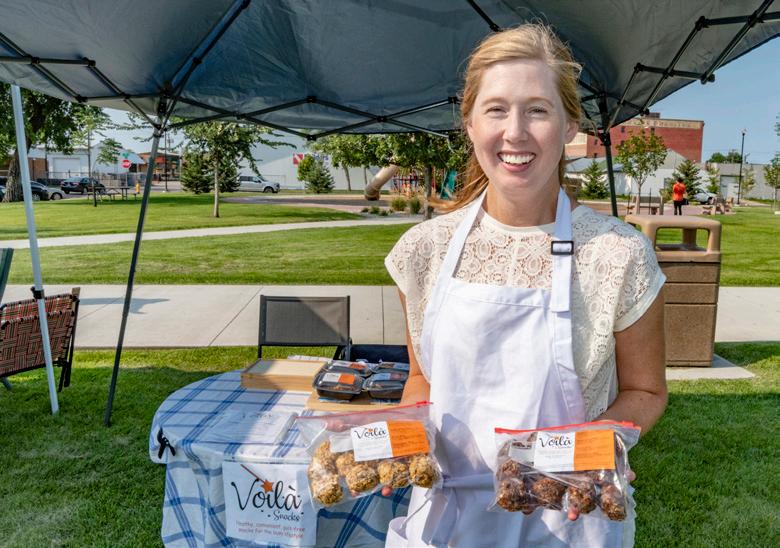


The mother of four explains she was determined to find snacks that, “A) filled my kids up until the next meal, B) were something they’d actually eat, and C) were good for them.” A tall order, but with research, she came across the world of bite-size, energy protein snacks. The only problem was, most of the recipes called for protein powder. “I didn’t want that. I just wanted real, whole, simple ingredients that are healthy for my kids.” After successfully making energy bites for her own family, Tracy started to think about providing these ready-to-eat snacks for other busy parents as well. She presented this idea at
Create Aberdeen’s Startup Weekend, and ended up winning the entrepreneurial competition. Since then, she’s been taking orders for her business, Voilá Snacks,



from customers at the Aberdeen Farmer’s Market on Thursday afternoons, and through her company Facebook page. She says, “Life is busy to the brim, so this is an option for people to have healthy snacks on hand and ready to grab.” // — Jenny Roth For more information on Voilá Snacks, visit www.facebook.com/voilasnacks

826 6th Ave SE • Aberdeen, SD 57401 • blackknightpools@yahoo.com Hot Tubs • Pools • Saunas • Swim Spas Pool Tables • Foosball • Shuffleboard • Games 605-226-9074 CALL NOW!
visit with our friendly staff about pre-need arrangement options or transferral of existing pre-arrangements 225-0691 • N Hwy 281 www.schriversmemorial.com Schriver’s Memorial Mortuary & Crematory Second Generation Family Owned and Operated Over 55 years of committed service to Aberdeen and surrounding communities
Come
BUZZ
Brett, Gary, Becky & George
Photo by Troy McQuillen
12 ABERDEEN MAGAZINE september/october 2018
Voilá Snacks puts deliciousness into every bite. Owner Tracy Vogel makes four flavors of homemade snacks that you can pop in your fridge or freezer and eat on the run, including vanilla almond, double chocolate, monster, and oatmeal raisin.
SEPTEMBER & OCTOBER
AAUW BOOK SALE

Sept 6, 6:00 PM-9:00 PM, Sept 7, 7:00 AM- 9:00 PM, Sept 8, 7:00 AM-1:00 PM
Super City Mall
Find a page turner at the American Association of University Women’s 50th annual used book sale. About 15,000 books will be available to browse through, and most will be priced under $3.
GYPSY DAY PARADE
September 29, 9:00 AM
Main Street
Free
Join your fellow spectators as they line Main Street in celebration of NSU’s homecoming week. This is the largest parade in South Dakota, and includes over 200 entries of area marching bands, groups, and floats.

OKTOBERFEST
October 6, 1:00 PM-11:00 PM
Aberdeen Civic Arena
$5, kids 10 and under free
NESD CELTIC FAIRE AND GAMES
Sept 14, 3:00 PM-10:00 PM
Sept 15, 8:00 AM-10:00 PM
Centennial Village
Adults $10, Children 5+ $5
Travel back in time as you stroll through a living, historical Celtic village, complete with traditional food, music, dancing, games, workshops, and more. All ages are invited to this family-friendly event.
SOUTH
DAKOTA FILM FESTIVAL
September 20-23
Capitol Theatre
For admission options, contact the Capitol Cinema box office at 605-226-5494
Take part in four days of film screenings and discussions featuring the work of various filmmakers from across the Great Plains region. Visit www.southdakotafilmfest.org for a complete viewing schedule.
Bring in October with traditional German food and entertainment, craft beer tasting, dachshund races, the state Hammerschlagen Championship, and other Bavarian activities.


AAHS RESCUE RUN
October 6, 8:30 AM-12:30 PM
Centennial Village
$25-$35
Lace up your shoes and walk or run for Aberdeen’s furry friends at this benefit for the Aberdeen Area Humane Society. Canine companions are welcome on the race course, but not required.
PUMPKIN PATCH FOR KIDS
October 7, 12:00 PM-3:00 PM
Centennial Village
Free will donation
Fall traditions abound as children ages 10 and under are welcome to pick their own pumpkin and take a ride on the barrel train.
HAUNTED FOREST
October 26, 6:30 PM-10:00 PM
October 27, 1:00 PM-3:00 PM 6:30 PM -10:00 PM
Wylie Park
Matinée $3, evening $13
Enter the forest if you dare at this annual Halloween spooktacular event. A special matinée performance for younger children that includes trick-ortreating will take place on Saturday afternoon.
CULTUREFEST

November 1, 5:30 PM-8:00 PM
NSU Barnett Center
Free
Celebrate cultures from around the world with international food samples, entertainment, and educational booths.
PUMPKIN PAINTING
October 17, 7:00 PM–8:30 PM
K.O. Lee Aberdeen Public Library
$8
All the painting supplies and styrofoam pumpkins are provided, so the only thing you need to bring to this fun-filled evening is yourself. Tickets go on sale September 10.
CALENDAR
14 ABERDEEN MAGAZINE september/october 2018
PUMPKIN PECAN BARS
 by TARA SCHIPKE
by TARA SCHIPKE
Nothing says fall to me more than filling my home with the wonderful smells of baked goods. This pumpkin pecan bar is not only delicious, but making it is easier than pie. So instead of rolling out pie dough, put this dessert in the oven and spend that extra time with your family and friends.
And there’s no need to worry about who ate the last piece with this recipe. A 9 x 13 inch pan will make about 24 servings. //
INGREDIENTS
SHORTBREAD CRUST:
1 cup All-purpose flour
1/2 cup old fashioned or instant oats
1/2 cup brown sugar
1/2 cup + 2 Tbsp. butter, softened
PUMPKIN PIE LAYER:
3/4 cup granulated sugar
1 can (15 oz.) canned pumpkin puree
1 can (12 oz.) evaporated milk
2 large eggs
2 1/4 tsp. pumpkin pie spice
1/2 tsp. cinnamon
1/2 tsp. kosher salt
PECAN PIE LAYER:
2 large eggs, beaten
1 cup brown sugar
1 cup light corn syrup
2 Tbsp. melted butter
1 1/2 tsp. vanilla
2 cups chopped pecans
OTHER SUPPLIES NEEDED:
9x13 inch pan
Pan spray
Whipped cream
HOW TO MAKE IT
1. Preheat oven to 350 degrees Fahrenheit and spray a 9x13 inch pan with cooking spray.
2. Combine shortbread crust ingredients in a medium-sized bowl and beat until mixture is crumbly. Press into the bottom of the pan and bake for 15 minutes at 350. Remove from oven.
3. Combine pumpkin pie layer ingredients in a separate bowl and mix for 1-2 minutes.
4. Pour pumpkin pie mixture evenly over the baked shortbread crust.
5. Mix pecan pie layer in a medium-sized bowl until combined. Pour over pumpkin pie layer.
6. Bake at 350 for 1 hour.
7. Cool completely and top with whipped cream (optional) before serving. Store in refrigerator.
RECIPE
As the weather gets cool, warm up with a baked treat that’s full of pumpkin spice and caramel pecans
Photo by Troy McQuillen
16 ABERDEEN MAGAZINE september/october 2018
ARTFULLY ADORNED
Metalworking is an art form for senior goldsmith Cherise Mayer

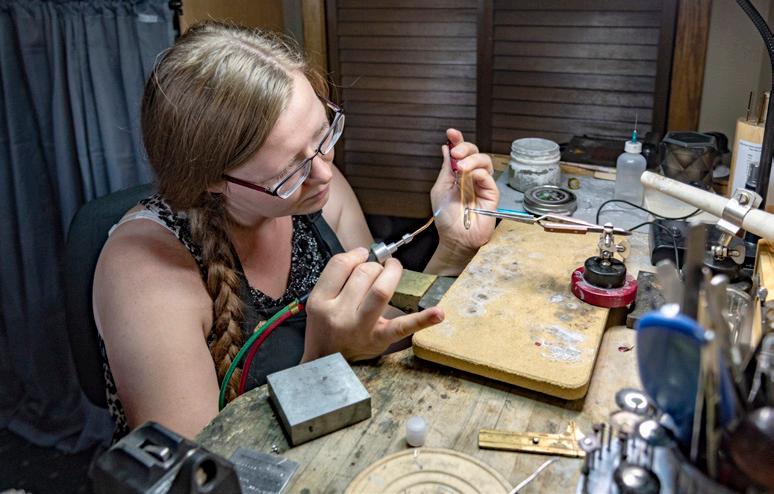
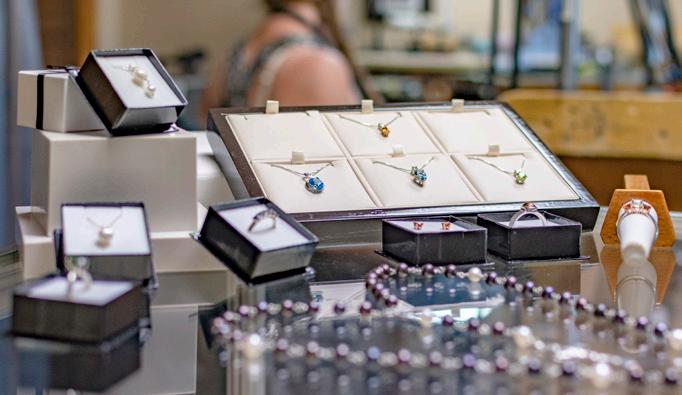
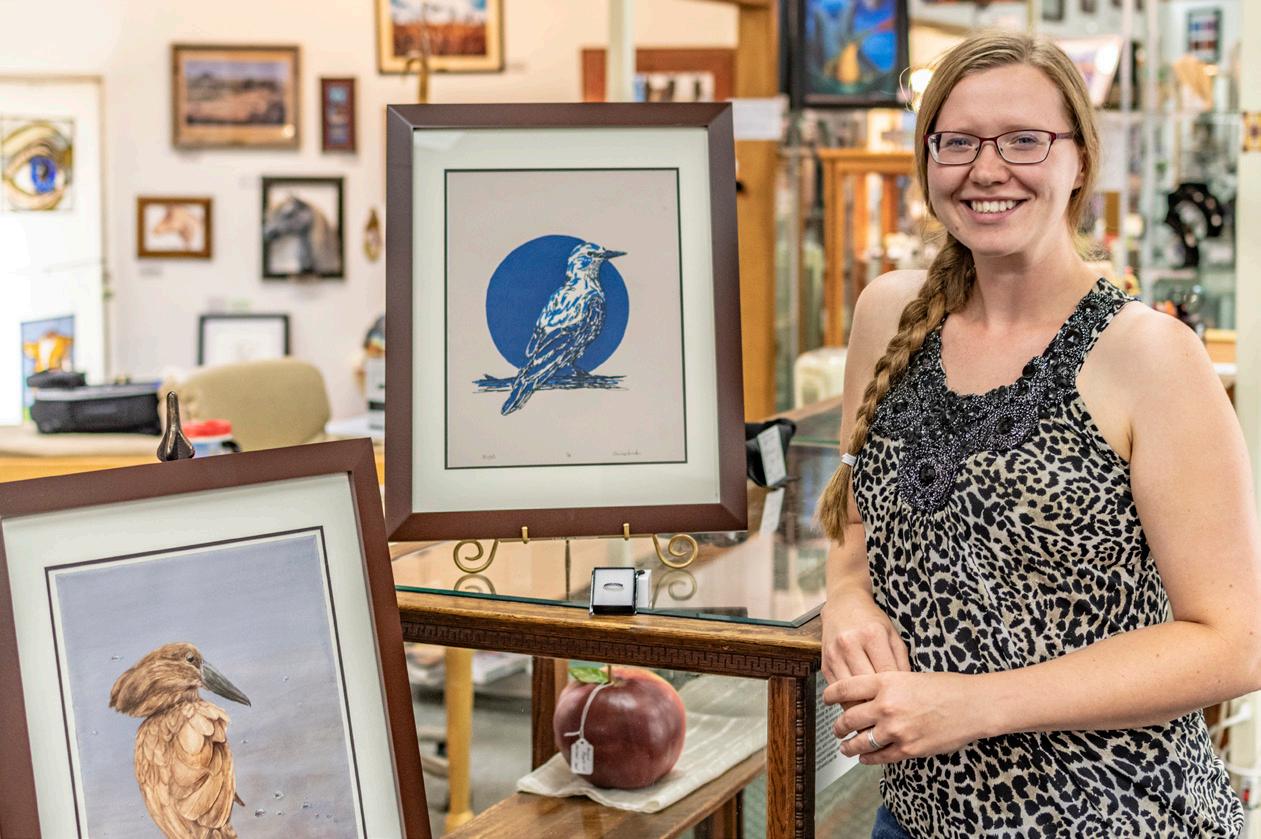 by JENNY ROTH
by JENNY ROTH
On most afternoons, you can find Cherise Mayer soldering, sawing, forging, filing, casting, and polishing precious metals for her homebased jewelry business, Artsmith Adornments. While she uses intricate tools to fashion raw materials into gold and silver jewelry, two notable awards hang in the background. One is for being a top producing goldsmith for Riddle’s Jewelry (she is, in fact, one of the top five in the company), and the other is for earning the title of senior goldsmith. To add to these accomplishments, she is working to reach yet another smithing milestone. “I have a few tests left to pass to become a master goldsmith, but I’m working on it,” she says.
Cherise has been a goldsmith and silversmith since she began an apprenticeship with Riddle’s in 2012. Because of her background, she was able to complete the coursework more quickly than most traditional students. For one thing, she already knew going in how to weld, a skill she learned growing up on a ranch near rural Buffalo, South Dakota. This is also where her older sister first taught her how to make jewelry.
PROFILE
Photos by Troy McQuillen
18 ABERDEEN MAGAZINE september/october 2018
Additionally, before joining the apprentice program, she had earned her bachelor’s of fine arts from NSU. After college, she gained more experience in jewelry making by spending two years teaching wire wrapping and beading classes at The Bead Co. in Sioux Falls, before moving back to Aberdeen with her husband, Josh.



From setting all the stones, to doing all the soldering, Cherise fabricates each piece of her jewelry by hand. She will start from scratch with just sizing stock and wire, or take a single part and build around it. The amount of time it takes her to create a design varies. She says, “Sometimes I work on a project for a couple of hours, or sometimes it can take a few days or even a week, depending on how complicated it is or how many stones it has. I’m building everything by hand, so I take my time to make sure I’m doing all the steps correctly.”
In addition to her home studio, Cherise’s jewelry is on display alongside her paintings and lithography prints at the ArtWorks Gallery in the Aberdeen Mall. Having an exhibit at ArtWorks helps get her name out in the art world, and also gives her a place to meet with clients. Even though Cherise is busy with her business and raising her three young children, she decided she didn’t want to wait for the perfect timing to join the gallery. “I’ve always wanted to be a part
of ArtWorks, even while I was in college, but then I’d always think I couldn’t do it because I didn’t have enough time. I finally realized I’m never going to really have the time, so I’m just going to do it now.”




Cherise paints watercolors and acrylics as a side passion, and created lithography prints while in college. All of her paintings and prints share birds as their common theme. “I really prefer wildlife when I paint,” she explains, “I think it’s because I grew up in that rural environment, we did a lot of hiking and outdoor activities and I even worked for the U.S. Forest Service in high school, so it just reminds me of home.”


Out of all her work, her watercolors and jewelry are her favorites. She even adds, “I have a couple of watercolors for sale now that I’ve been holding on to for a while because I really just love them so much.” While she likes to try her hand at all kinds of art, metalworking has become her true medium of choice. “All artists are kind of tinkerers, we like to dabble in everything. But when you find your medium that is the biggest thing, because for most of us there is that one thing that we like to do more than anything else. For me, that’s metalworking.” //
Cherise is available to meet clients interested in jewelry design and repair by appointment at the ArtWorks Gallery in the Aberdeen Mall. Her jewelry, paintings, and prints are on display during the gallery’s regular hours, which are Thursday through Saturday from 11:00 AM to 6:00 PM, and Sunday from 12:00 PM to 6:00 PM. For more information, visit www.facebook.com/ artsmithadornments.
2018 NE South Dakota READERS’ CHOICE Construction Company WINNER 3011 8th Avenue NE #201 | Aberdeen 605.725.0050 | www.jdhconstruction.biz 100% Locally Owned & Operated
A trained goldsmith and silversmith, Cherise repairs jewelry and hand fabricates her own original pieces.
september/october 2018 ABERDEEN MAGAZINE 19
All of Cherise’s paintings (left) and lithography prints (bottom) share birds as their common theme.
Salesi and Mele Mounga share how they’ve built their life in Aberdeen
 by JENNY ROTH
by JENNY ROTH
f you get the chance to meet Salesi and Mele Mounga, you’re guaranteed two things. The first is that you’ll be blown away by the kindness they extend to everyone around them. And the second is that their sense of humor is going to make you laugh, probably at least a few times. The couple has been married for 20 years, and they joke about the unusual location they chose for their honeymoon: Aberdeen, South Dakota. Mele remembers, “We got married in Utah on Thursday, and then that Sunday we started the long, 18-hour drive to Aberdeen.” Salesi adds, “Actually I think it took even longer than that to get here, because we got lost.”
Salesi and Mele were both born in Oahu, Hawaii. They met years later while living in Utah, and at that time neither of them imagined creating their life together in Aberdeen. Salesi attended Snow College where he graduated with an associate's degree and was recruited to play Division I football for the University of Maryland, until an injury hindered his plans. The following season, his older brother, Peni Mounga, went on a recruiting visit to NSU that had been orchestrated by their cousin, Lisiate Otuafi, a former NSU Football All Star. Peni and Lisiate understood that Salesi wanted to go to school and play football as well, but that he would need some convincing to move to South Dakota. So a home video was produced to show him what Aberdeen was like. Sort of. “The joke is we got here on a lie,” Salesi laughs. “The video was exciting and made it appear that
downtown Main Street was super busy. My cousin got down on the sidewalk and filmed the Capitol Theatre lights to make it look like it was this big city and said, ‘See it’s a big city, and they have a huge Division II football program, come out here.’”
The home video did the trick, and Salesi and Mele both enrolled at NSU, with Salesi also on board as a free safety for Coach Ken Heupel’s football team. The Moungas still remember the culture shock of seeing Aberdeen for the first time. Having never been to South Dakota, they stopped at the M & H Gas Station and thought they were at another gas stop along the way, when Lisiate pulled up. “I thought maybe he was meeting us halfway to greet us or something, but he was laughing, literally laughing. That was our introduction to Aberdeen.”
UP CLOSE
Photos by Troy McQuillen
The Mounga family standing left to right, Zeezrom, Ilima, Salesi Jr., and Mele. Sitting, Sami and Salesi.
20 ABERDEEN MAGAZINE september/october 2018
Along with finding out the town was smaller than they had imagined, and that the climate on the plains was a lot different (and colder) than the mountain region they had loved in Utah, another obstacle surfaced. People in Aberdeen were unfamiliar with Polynesians, and Salesi and Mele quickly found a routine to help avoid some of the social challenges and differences. Being newlyweds and finding those social circles on and off the NSU campus also made daily life interesting. But instead of shrinking back, the Moungas and their family members decided to share their culture and bring more diversity and understanding to the Aberdeen community. Coach Ken Huepel had established a junior college influx and recruitment pattern at NSU, and over the next few years the university would host nearly 70 Polynesian students and families on campus. The Moungas say it was encouraging to be around people they knew, but that they could still see others saying, “Who are all these people coming in from out of state?” Because of this, Peni started the NSU Polynesian Club. Salesi says, “Our purpose was to educate, serve, and live the teachings of our parents.” They hoped this education would help eliminate any negative or incorrect stereotypes, and at the same time help others understand their culture and traditions. Club members went to various schools and events in Aberdeen and the surrounding area, performing cultural Polynesian dances and hosting outreach programs. Salesi explains, “Our shows were educational, and even though people
sought them out for their entertainment, that really wasn’t the purpose. It was for us to say, ‘We’re in your community, this is who we are.’” Mele adds, “It really helped us feel comfortable because we felt like a part of the community, and accepted as part of the community.”
During their time at NSU, Salesi and his brothers also found other opportunities to share their Polynesian heritage, not only with cultural dances and food, but also with rugby. In 2000, Salesi, Peni, and four other family members and former NSU standout athletes, Naki Angilau, Tefu Bloomfield, Alema Atuaia, and Motulalo Otuafi, started a rugby club and introduced the sport the way their fathers had taught them to play in their childhood. Their club was initially recognized as the Dakota Outlawz Rugby Football Club under the Great Plains Union of South Dakota, and affiliated

with USA Rugby, the national governing body for the sport of rugby in America. It continued to grow throughout the Midwest with enormous success as a respected powerhouse club, and eventually gained the support of NSU. In 2007, the club changed its official name to Northern State University RFC, and in 2009, they won the USA Rugby National Championship. Salesi says, “The body of work accomplished by this group on and off the field of play is astonishing in comparison to other teams and academies in their division.” Today, the rugby club continues with guidance from its founding members, and is supported by veteran NSU students.
After attending NSU for two years, the Moungas started a family. Mele became a stay-at-home mom and focused on taking care of the couple’s four children, Salesi Jr. (17), Sami (16), Zeezrom (14), and Ilima

september/october 2018 ABERDEEN MAGAZINE 21
Salesi is the director of operations and Mele is the manager at The Oil Room in Aberdeen. When they aren’t at the store or attending one of their children’s activities, the Moungas also operate their own personal business with doTERRA Essential Oils.
(13). Salesi earned both his bachelor’s and master’s degrees from NSU, and has worked at the New Beginnings Center for Lutheran Social Services, Avera St. Luke’s Worthmore Addiction Services, Central High School, and at Northern State University as the director of residence life and student rights and responsibilities (student conduct). He is quick to credit his wife more for the work she has done in raising their four beautiful children. “Looking back on all the jobs and responsibilities I’ve had, none of them compare to what she’s done and the sacrifices she’s made in raising our children. We are so proud of them, and they are who they are because of their mother.”
Now that their children are in school, Mele has returned to the workforce. She is currently the client relations manager at The Oil Room, and Salesi works there as well as the director of operations. When they aren’t at the store or attending their children’s activities, they spend a portion of their personal time operating their own health and wellness business with doTERRA Essential Oils. Last year, for their efforts in sales and growth, they came out first among hundreds of others to win a
nationwide Diamond Club competition hosted by doTERRA. Mele says, “What we enjoy about working at The Oil Room is serving people and helping them achieve a better and healthier lifestyle. And with our own business, we love having our children be a part of it and sharing our experiences with others and hearing their stories.”
Over the years, Aberdeen slowly became home to the Mounga family. They say this is in part due to all the friendships they’ve made at their church and with the NSU community. As members of The Church of Jesus Christ of Latter-day Saints, they were able to find solid ground with the challenges of day-to-day routines. For eight years while Salesi worked on campus, he, Mele, and their children also lived in the residence halls at NSU. Part of their job was to help students living in the residence halls build healthy relationships and get connected with campus life. When they hosted social programs or made rounds, they always brought their children along. Salesi says, “Students would say that seeing our kids reminded them of their siblings back home, so they’d come to those socials for that family connection. It made for a
more family-oriented atmosphere, and at the same time, our kids were getting a lot of attention!” An advantage of living in Aberdeen that they noticed as their children started to grow up is that compared to so many areas, it is a good, safe place to raise a family. Mele says, “Our kids have been able to be involved in so many things here, not only sports but things like show choir, band, debate, and senate.”
One thing the Moungas still struggle with in South Dakota? The long winters. They joke, “Every year people say, ‘Oh this was a mild winter.’ And we laugh because they say that every year.” Although the NSU Polynesian Club is no longer a formal group, Salesi and Mele’s children, nieces, and nephews continue with their family’s tradition, and are the new generation performing cultural dances and outreach activities. Sharing their heritage with their children is important to the Moungas, and in everything they say it is evident that they are centered on their faith and family. Mele says, “We always celebrate our anniversary with our children, even on our 20th this year, we spent the entire day with them. They are truly our blessings.” //


Attention Hunters!

Designing the next big step for your small business

12800 SOUTH SHORE DRIVE • RICHMOND LAKE DRINKS • FOOD • LODGING • SPECIAL EVENTS • SHUTTLE SERVICE 605-226-2929 Tues- Thu: 4–10PM, Fri: 4–Close Sat: 11–Close, Sun: 11AM–10PM
Away is your one stop for great drinks, food and service!
taking reservations for the 2019 pheasant season.
our “Hunter’s Menu!” We are dog friendly! 22350 4x5 4c
Anchors
Now
Try
a lot involved in taking your business to the next level — from financing expansion and improving cash flow, to marketing services and transition planning. You’ll find
to
your business
wellsfargoworks.com
There’s
the ideas and solutions you need
grow
at
Aberdeen Downtown • 204 S. First St. • 605-225-2220 ©
22 ABERDEEN MAGAZINE september/october 2018
Let’s get started. Visit your local branch or find a time that works for you at wellsfargo.com/appointments
2018 Wells Fargo Bank, N.A. All rights reserved. IHA-22350
AIMING FOR THE FUTURE
The Great Plains Outdoorsmen are making it possible for the next generation to enjoy the great outdoors
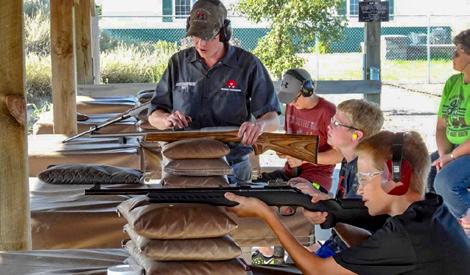 by JENNY
by JENNY
Arnie Goldade loved shooting sports and the South Dakota outdoors his whole life. Even before his father gave him his first gun at age eight, the Aberdeen native had already accompanied his family on the many hunting trips that they took together. Over the years he learned that if no one protects the outdoors, we could lose it. So he dedicated his time to preserving outdoor sports, and making sure others would have a chance to appreciate them too, by volunteering for various Aberdeen area conservation and wildlife organizations. One of these was the Great Plains Outdoorsmen (GPO), a nonprofit that raises money for programs within a 100-mile radius of Aberdeen that support outdoor activities and shooting sports, including those for youth, veterans, and women.
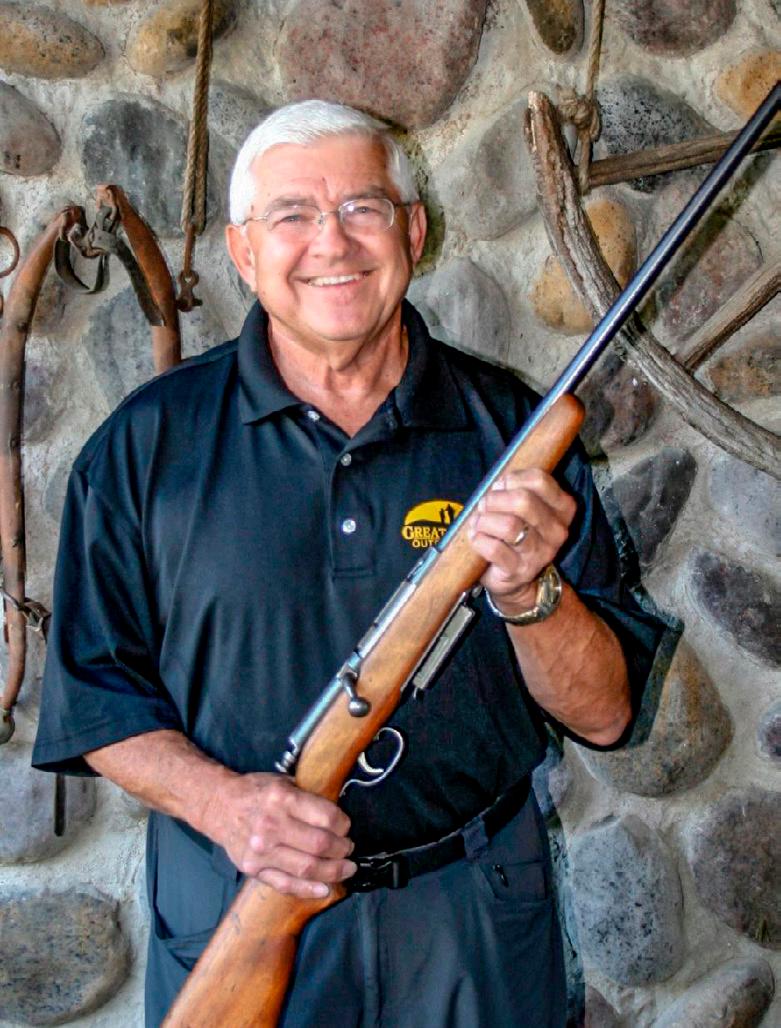
Before forming GPO in 2011, some members were on a committee for Friends of the National Rifle Association, but decided to branch out on their own so they could have complete control of the funds they raised and give them all back locally. Arnie served as the first chairman with GPO, but sadly lost his battle with cancer in 2016. Current GPO Chairman Scott Eisenbeisz says that Arnie got the ball rolling for GPO to be successful, and that the remaining 22 members of the group have worked to continue what he helped start. “We definitely didn’t want the group to disperse. We wanted to keep with it, and we’re going as strong now as we’ve ever been going.” This is true, and the proof is in the numbers. To date, GPO has donated well over $900,000 dollars in financial grants to local outdoor programs, facilities, and educational opportunities. This coming year, they’re looking forward

to reaching and surpassing the $1 million mark in grant funds raised.
Starting in November, GPO members meet weekly to prepare for their annual fundraising banquet that takes place every February at the Ramkota Hotel in Aberdeen. One of the best-attended sportsmen events in the region, it brings in about 700 ticket holders. During their first meetings, GPO members decide which prizes will be given away, auctioned, or raffled during the banquet, and put together a catalog of these items. They choose high-quality merchandise prizes, including about 150 guns. After they have their prizes planned, members go out into the community and get help from businesses and individuals who donate to, or underwrite, each item. This way, they go into the banquet with everything paid for, and every dollar made that evening is profit to be donated. Scott says GPO emphasizes supporting local businesses, and encourages their grant recipients to purchase locally too. “We couldn’t do this without all the local businesses. They’re really the ones that make it possible for us to do what we do.”

UP CLOSE
“We’re going as strong now as we’ve ever been going.”
ROTH
An avid outdoorsman, the late Arnie Goldade helped start GPO in 2011, and served as the organization’s first chairman.
24 ABERDEEN MAGAZINE september/october 2018
GPO supports local outdoor and shooting sports programs, including those for youth, women, and veterans.
Photos courtesy of Great Plains Outdoorsmen
The 2018 GPO banquet raised over $123,000 that was given out in about 40 separate grants, a significant increase from the $75,000 they made their first year. Once all the funds are in and they have a final dollar amount to work with, the next thing members do is read through all the applications for grants that they receive and determine how they can help. Finally, during an awards ceremony in May, they present checks to their grant recipients. They’ve donated to a wide variety of outdoor programs, including those who put on hunts for veterans, women’s shooting sports teams, and youth groups for fishing, shooting, hunting, and archery. The thing most of their grant recipients have in common is that they are all small organizations, and while they raise money for themselves, the grant they receive from GPO is needed to keep their programs going. Scott says for him
the awards ceremony is one of his favorite parts of being a GPO member. “When we hand out the money in May to people and their kids who’ve tried hard to continue their programs, and we’re able to help them keep going, for me that’s the most memorable.” He adds that they also make it possible for some outdoor groups to get up and running.“This year we were able to give to high school trap shooting teams in Aberdeen and the surrounding area that are just in their first years, and really help them get a good start.”
In 2016, GPO won an ABBY Award for People’s Choice. Scott says receiving this award meant a lot to their group. “That was really a good moment for us. We’ve had nothing but support from the community as the years go on.” He adds that they’re always looking for more volunteers who’d like to join GPO. “We have young people, retired guys who have been in the outdoors for years, and people with all different types of careers. It’s really this mix that brings all the good ideas to the table.”



GPO members continue to put in the volunteer hours every year because of the benefits they see happening as a result of shooting sports and getting outside. Scott explains, “Kids growing up now have all this technology, but to be a well-rounded person we recognize the importance of getting outdoors too. The general numbers for a lot of sports are declining, kids just aren’t doing those things as much anymore. We’re trying to grow those numbers and help keep them involved.” //
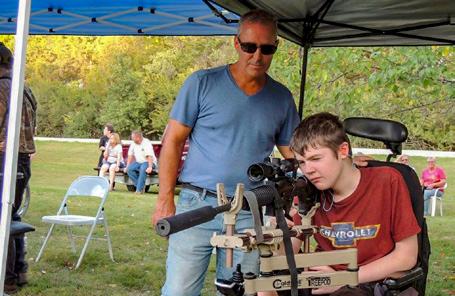
The 2019 Great Plains Outdoorsmen banquet is scheduled to take place on February 7. For questions about the banquet, tickets, or joining the GPO committee, contact Scott Eisenbeisz at 605-380-5668, email greatplainsoutdoorsmen@gmail.com, or visit www.facebook.com/GPOSD
Quality At Your Door step

With us, you can feel the quality in everything we do. Whether you need a timely fall tune-up or a mid-winter emergency repair call, we will keep your Tempstar® heating system running at peak performance. We’re proud of how Tempstar technology delivers quality comfort. Call us today, and stay cozy all winter long.



but
“We’ve had
nothing
support from the community as the years go on.”
© 2016 International Comfort Products Heating and Cooling Products
Become a Member ABERDEEN COMMUNITY CONCERT ASSOCIATION Purchase your membership at Interior Design Concepts in downtown Aberdeen or go online. Enjoy our great 2018-2019 lineup when you become a member today. MAUREEN MCGOVERN Sept. 12, 2018 FIVE SAX Nov. 19, 2018 CELLISIMO March 21, 2019 THE ABRAMS May 2, 2019 WWW.ABERDEENCOMMUNITYCONCERTS.ORG SOUTH DAKOTA JAZZ FESTIVAL CONCERT FEATURING NACHITO HERRERA Jan. 17, 2019 september/october 2018 ABERDEEN MAGAZINE 25
PULLING OUT ALL THE STOPS
Sacred Heart Church’s Big New Box of Whistles
by PATRICK GALLAGHER photos by TROY MCQUILLEN
When organ builder John Nordlie first saw the pipe organ at Sacred Heart Church in Aberdeen as a college intern in the early 1970s, his mentor told him its days were numbered. Nearly half a century later, John is taking care of it.
When they built the current Sacred Heart Church in 1933, parishioners saved some money by reusing the old church’s 1908 pipe organ. In 1954, they replaced that instrument with an organ that had 1,241 pipes. Any machine with thousands of parts needs attention, however, and maintenance became an issue after the parish, for whatever reason (but not a very far-sighted one), raised the choir loft floor, building it around the organ console and sealing off parts that needed servicing. Not surprisingly, this created problems. As Sacred Heart Pastor Father Mark Lichter summarizes, “Over time, the old organ slowly broke down.”
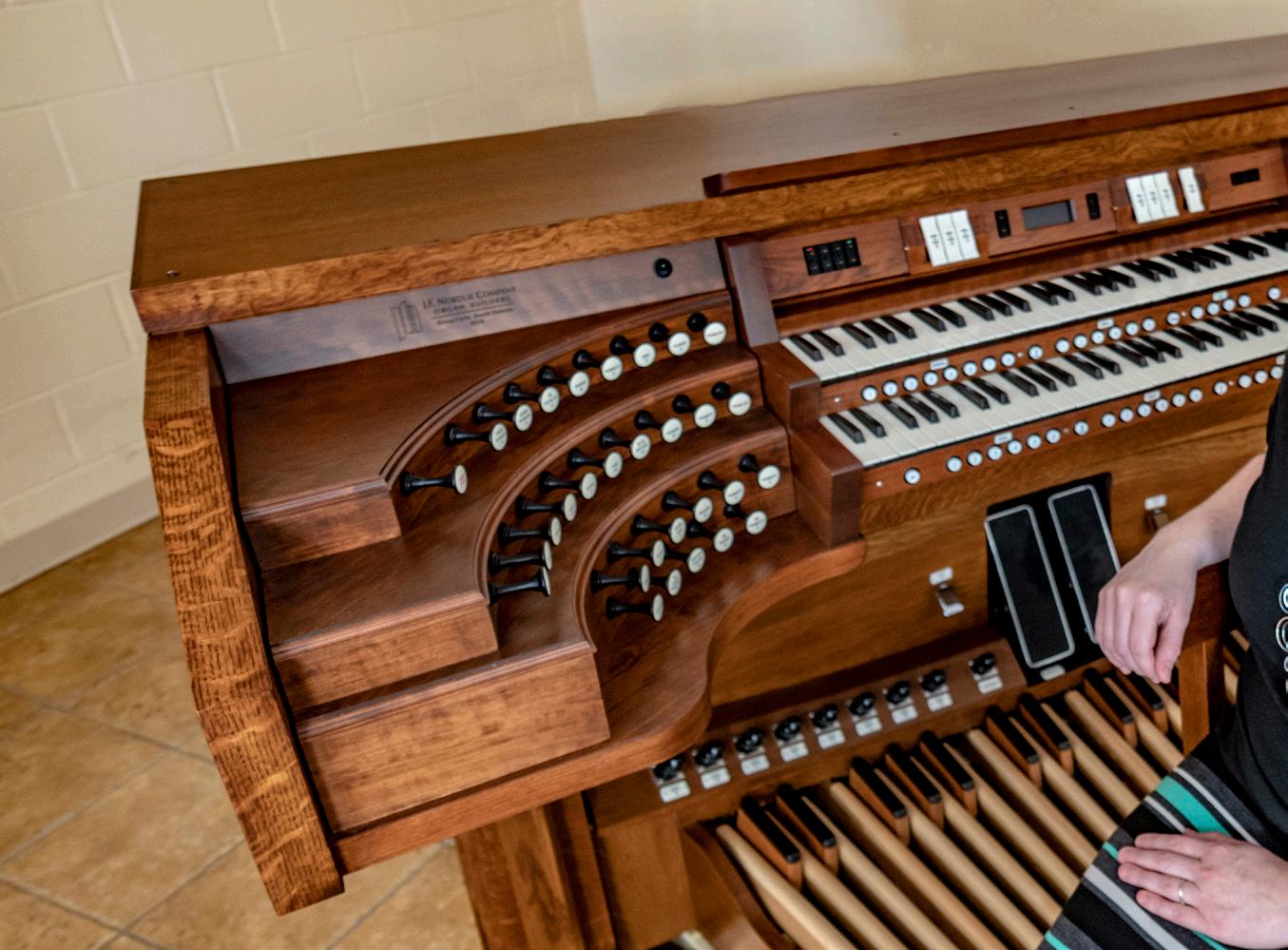
“Many pipes were unplayable,” expands Dr. Richard Fitzgerald, Sacred Heart’s organist in 2014-2015, and now director of
music and organist at St. Joseph Cathedral in Columbus, Ohio. “When a note or a pipe would not play, I had to finagle another pitch to play in its absence.” In addition, “The organ did not make use of the space provided for it by church architects. The result was an organ that was much too small for the building it was intended to fill with sound.” Carissa Baustian, the current organist, noted that the organ was installed in the corner of the choir loft, which, she says, “caused the choir to look toward the organ, so their sound didn’t project into the church.”
Clearly, the organ was in desperate shape, but the solution wasn’t an easy call. Repair wasn’t an option, but what should replace it? A new pipe organ or a different keyboard instrument? The cost difference was enormous, but so was the difference in sound quality. According to Father Lichter, “Parishioners have wanted to do something about the organ since at least the 1980s,” and
UP CLOSE
Organist and Director of Music for Sacred Heart Church Carissa Baustian sits at the console for the parishes’ new pipe organ. The console is shown on display before installation in the choir loft.
28 ABERDEEN MAGAZINE september/october 2018
the parish confronted that question in earnest again beginning in 2014, finally deciding in 2017 on a new organ. The cost, including the organ and renovations in the choir loft (e.g., lowering the floor), is about $700,000, surely one of the most expensive musical projects undertaken in Aberdeen, particularly for one instrument.
“We decided we had to replace what we had,” says Father Lichter. “The organ is part of the beauty of the place, and the building deserves to have what it had, as do the people. The generation that built the church did that for today’s parishioners, and we have an obligation to future generations.” After all, he explains, “If one of the great stained glass windows broke, we wouldn’t just replace it with a clear window.” Further, he noted the pipe organ’s long history in Christian worship. So they turned to John Nordlie.
“Fascinated by making things,” John became interested in pipe organs as a child, from a manufacturing, not a musical, perspective. In fact, he doesn’t play the pipe organ. At Augustana in the early 1970s, he met up with Eugene Doutt, an organ specialist from Watertown, and interned with him in Aberdeen at the old Bethlehem Lutheran Church, when he also visited Sacred Heart. After college, John joined Noack Organ Company in Massachusetts. After about two years, while delivering an organ to Minnesota, he received a call from an area pastor and ended up giving him a quote to build an organ. He set up shop at his parents’ house in Sioux Falls in 1976, and the rest is history. Since then, JF Nordlie Company has custom-built more than 50 organs, mostly across the Midwest, but some as far away as Japan, and serviced many more. It’s a combination of art and craft, science and passion, and John says he’s “been blessed to get to do what he wanted to do.”
As some experts put it, a pipe organ is basically a big box of whistles (pipes), each of
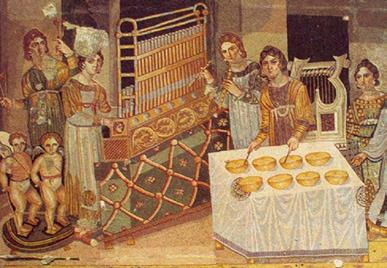
which is designed to produce a specific musical note with a particular tonal quality, such as to mimic another instrument. The organ has a constant supply of air to blow those whistles, and the organist controls where this wind goes by pulling out stops, selecting which sets of pipes receive the wind (the more stops, the more sound; hence “pulling out all the stops”= volume), and by depressing keys and pedals, which produce individual notes. With enough pipes and controls, a pipe organ might make the sounds of dozens of instruments and sound like an orchestra. No wonder Mozart called it the “King of the Instruments.”
Today, in what looks like a classic woodworking shop but with bells, whistles, and microchips, John Nordlie designs and builds organs with all the high-tech options available to him, including computer-aided design, computer numerical control, fiber optics, infrared, and solid state technologies. For Sacred Heart, he created a high-precision electric action pipe organ in the American Classic style, which allows it to play all types of organ music.

The console, which is made of quarter-sawn white oak, contains two keyboards in a cherry surround, plus the pedals (which constitute a third keyboard). It is situated front and center in the choir loft, but facing the back, so the choir’s voices project forward, not at an angle. Carissa Baustian uses a rear-view mirror to keep an eye on the celebrant. The new organ has 1,888 pipes, including about 850 that John’s crew salvaged and refurbished from the 1954 organ. The new pipes, which range from 16 feet tall down to a few inches, were made in Hermosa, South Dakota, Ohio, and the Netherlands, as well as in John’s shop. More than half of the pipes, including the beautiful wooden pipes, will be invisible, hidden in the chambers on either side of the choir loft. Four arrangements totaling more than 900 stunning gold and silver metal pipes flank the loft. The organ includes 22 registers, or distinct tonal sounds-sometimes called voices. Two electric blowers can breathe 5,000 cubic feet of air per minute into the organ (the average person would take five days to breathe that much air). It definitely will fill the building with sound.
So, now Sacred Heart will be all pipe organ all the time, right? Not exactly, Father Lichter says. “The organ is one of the ways of worshiping, not the only way. For some the organ is very important to worship, but people have all kinds of opinions. We will have a variety of music here.”
Still, the organ is designed to fill the big church with sound and music, so don’t be surprised if sometimes they pull out all the stops. //
WHY ARE PIPE ORGANS IN CHURCHES?
Tradition, to begin with, of course. Pipe organs have been part of Christianity since Charlemagne ordered one for his chapel in the ninth century. Then there’s all the music. “More music has been written for the pipe organ than for all other instruments combined,” John Nordlie says. It’s the only single instrument that can produce enough sound, unamplified, to fill a church while being agile enough with a single performer to improvise and respond to situations-imagine an orchestra adjusting to a celebrant with no sense of rhythm.
Father Lichter also suggests a natural connection between worship and the pipe organ, “The pipe organ is the closest instrument to a human voice-the wind, the air. It’s like breathing.” Maybe not so ironically, organ builders speak in terms of the voice of pipes. “When pipes come from the pipe maker, they don’t speak at all,” John says, until the crew member, called the voicer, cuts the pipe to create the “mouth”-an opening, like the hole in a whistle-to give it its unique voice. (Pipes also often have a foot, toe, body and tongue.) This makes the pipe organ “the ideal instrument to lead a congregation in song,” argues Richard Fitzgerald, because “it is much like the human singing apparatus. Simply put, the organ utilizes wind-filled pipes to make music while we use our wind pipes to sing.” In the oldest sense of the word, it inspires the congregation (inspire, with roots in the Latin spirare, “to breathe”which is also the root of spirit-and the Middle English enspire, with original connotations of the divine).
Sioux Falls organ maker, John Nordlie, works on an access door. Not only are they building everything, they are building access so they can service the organ over the years.
30 ABERDEEN MAGAZINE september/october 2018
4th century AD "Mosaic of the Female Musicians" from a Byzantine villa in Maryamin, Syria.
VOICES of ABERDEEN
Talking about Sports in the Hub City
When I was a kid shooting hoops in my driveway or hitting a baseball by myself, I often kept up a play-byplay commentary about my game. After all, “What good is it to knock out a ghostly home run, or dunk a phantom basketball, if the world does not hear of it and shout approval?” as the intellectual Garry Wills wrote in his introduction to a Doonesbury collection, “Almost every boy who has ever dabbled in sports has spent hours being three things all at once-performer, announcer, and fan.” Many of us have done this kind of playby-play-about ourselves. It takes another evolutionary step to do it about someone else, and that’s the job of real play-by-play announcers. And what a great job-to have to watch sports, and talk about it! I visited with a few guys who have been talking about Aberdeen sports for decades.
Current Aberdeen Mayor Mike Levsen started as a radio man. He joined KSDNAM in 1967, when the station was covering Central, Northern, and Aberdeen Pheasants baseball games. For the latter, the announcer sat in the studio rather than the stadium and did “re-creates.” On the air, he described plays he invented to fill in the gaps in time between the game updates phoned in from the field (this is how Ronald Reagan got his start). In a few years, Mike began broadcasting games, and later became station manager. “Doing sports was the fun part of the job though,” he says. “Selling commercials and playing records isn’t too exciting.” And he needed help.
“I always wanted to do play-by-play after I realized I wouldn’t be a pro athlete,” says Gene Reich, who retired this year after more than 30 years of announcing. After college, he got his first radio job in Huron, where he announced a few hockey games
by PATRICK GALLAGHER
as well as some games in the first-ever state girls’ basketball tournament. Then he covered sports for the Aberdeen NBC TV affiliate and a Cedar Rapids, Iowa, TV station, where his first assignment was covering tennis stars Vitas Gerulaitis and Rod Laver. Back in Aberdeen in 1980, Mike Levsen hired him.


Together or separately, Gene and Mike did play-by-play for Central, Roncalli, and Northern football and basketball games. They also did state basketball tournaments even when local teams weren’t playing. “The tournaments weren’t always on TV back then,” Mike says, “and they were really profitable for the station.” In a typical March, Mike and Gene might broadcast 50 games altogether. “Mike and I were really busy doing all these games,” Gene recalls.
Another Aberdeen native, Scott started his radio career in Gregory and Redfield before returning to KGIM-AM in Aberdeen in the late 1980s. His first football play-byplay was in Ipswich. “They put me on top of a school bus with a table,” he remembers. “I learned that buses have a curved roof, so I didn’t move much.”
In the mid-1990s, KGIM also started broadcasting Central games-the same ones KSDN was covering. This duplication continued into the early 2000s, a time of lots of upheaval in the Aberdeen radio game. Ownership of the stations changed, and staff changed too. Mike and Gene left KSDN, and Gene did play-by-play parttime at KGIM for a while. By about 2005, all the commercial stations in Aberdeen were
FEATURE
“Then Scott Solberg came along.”
Photos by Troy McQuillen
32 ABERDEEN MAGAZINE september/october 2018
Aberdeen Mayor Mike Levsen spent years calling baseball, basketball, and football matchups.
owned by one company (for a while), and the staffs merged. There was a lot of figuring out who was doing what, and with so many stations doing lots of games, Scott says, “Sometimes you forgot what station you were on.” They could be long days, particularly when winter messed up schedules. Scott recalls “starting a day with my 5:00 AM on-air shift, selling ads during the day, driving to Yankton for a game, getting back at 2:00 AM, and then being on the air again at 5:00 AM the next day.”
Around that time, Scott’s son was starting high school at Roncalli, and he went to watch an out of town game. “The radio announcer had a problem getting there and couldn’t do the broadcast,” Scott remembers, “so I thought, I’m going to be there anyway-I can do the games.” That started a 14-year (and counting) relationship doing Roncalli sports and, Gene says, “Making my life easier.”
Basketball was a much bigger part of these announcers’ careers than other sports. Covering both male and female squads meant three to four times as many games each year as football. “Doing basketball is a different animal,” Scott says. “The gyms and accommodations are all very different. I’ve done games from what seemed like penthouse suites and while sitting in the middle of the opposing cheering section.” He also made sure to mention, “The best place from an announcer’s standpoint to do a game is the Aberdeen Civic Arena! Where we sit now-front row of the balcony, mid-court, behind the scorer’s table-is the perfect blend of having a view and being in the middle of people, so you feel like you’re really involved in the game.”
THE VOICE OF THE WOLVES
For the NSU men’s national championship basketball game this year, Hub City Radio’s Ben Root decided to break tradition. The sports broadcaster usually wears a Wolves polo to call games, but made a pact that if the team made it to the championship game, he’d put on a suit for the occasion. “Then lo and behold, they made it to the championship. It was the first time I broke out a suit for a game,” he says. Calling that game, and the semi-final one before it that went into double overtime, are two of his favorite memories of being a sports broadcaster for the last 15 years. This is Ben’s 5th season as the Voice of the Wolves. Throughout the year, he does play-by-play for as many basketball, football, and baseball games, and home volleyball matches, as he can get to. “If there’s a game, I’m trying to cover it in some way,” he says. Before coming to Aberdeen, Ben worked in radio all over the country, including in his home state of California, as well as in Washington, Wyoming, Nebraska, and Milbank, South Dakota.
In recent years, he’s received a couple of standout awards for his successful career in sports broadcasting. One is a place on the Wall of Honor for KBPK, a station at Fullerton College in California, where he received his broadcasting degree and first job in radio. He was also awarded the 2016 SD Sportscaster of the Year through the National Sports Media Association, becoming the first Aberdeen broadcaster to win the honor.
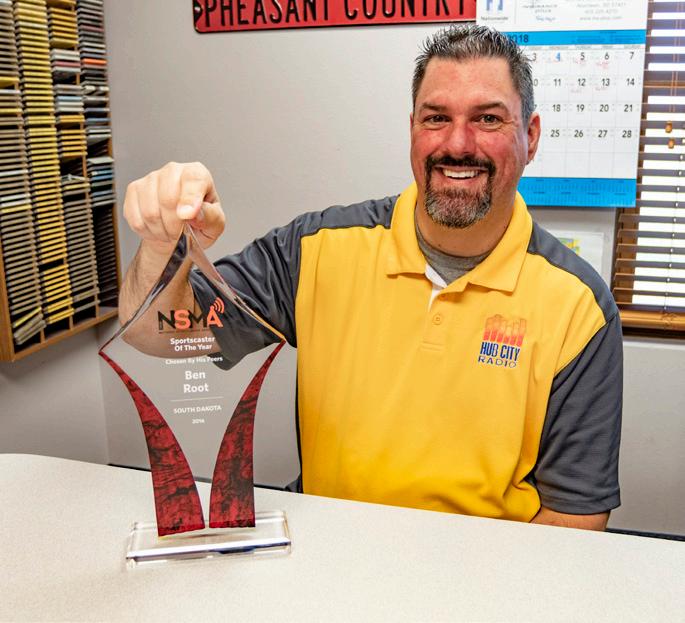
Ben says he was a “math geek” growing up and didn’t play a ton of sports. In fact, he earned a degree in engineering before a sports broadcasting class at a community college got him interested in a career in radio. He likes doing play-by-play because you never know what’s going to happen in a game, or exactly what to expect. “There’s never the same game twice, and there’s always something exciting or unexpected, like an amazing play or a team comeback.” Before he called games for NSU, he also did play-by-play for high school, and says another part of the job he enjoys is getting to see the achievements of athletes at these levels. “It’s just really being happy for these players and kids and getting to see their accomplishments.”
 Ben Root is the first Aberdeen sportscaster to win the National Sports Media Association’s Sportscaster of the Year Award.
Ben Root is the first Aberdeen sportscaster to win the National Sports Media Association’s Sportscaster of the Year Award.
september/october 2018 ABERDEEN MAGAZINE 33
Gene Reich recently retired from a career in radio announcing that spanned over three decades.
TUNE IN THIS FALL
Regional Sports brought to you by Dakota Broadcasting and Hub City Radio
Dakota Broadcasting
High school football matchups are hitting the airwaves on Dakota Country 105.5FM, with live streaming videos at Dakotabroadcasting. com, courtesy of Lucas Quail and Adam St. Paul

September 2
North Border vs. Northwestern
September 9
Langford vs. North Border
September 16
Webster vs. Great Plains Lutheran
September 23
Britton Hecla vs. Florence Henry
September 30
Ipswich Edmunds Cent. vs. North Border
October 5
Redfield Doland vs. Groton
Hub City Radio
Ben Root
NSU sports games on Fox Sports
107.1FM and 1420AM
Dave Tukesbrey
PC Saints on KSDN 102.1FM and 930AM
Scott Solberg
Roncalli sports on Pheasant Country
103.7FM
Zach Swanson
Central High School on FOX Sports
107.1FM, 1420AM, and 106.7 Point FM
Jay Kleinknecht
Wings hockey on The Rock 94.1FM
Mark Cochran
Hotshots baseball and Redfield area sports on KQKD 99.9FM and 1380AM
Dave Vilhauer
Stories and updates for all our area sporting events and games

All Broadcasters
Aberdeen Christian games and area sports on Sunny 97.7FM
There are many memories from a combined 80 or so years of sports broadcasting. For Gene, one of the best was one of the few baseball games he ever got to do (the real thing, not “re-creates”), including the Aberdeen Smittys 2007 state championship, which they won in Aberdeen. “That was a big deal for me,” he says. “I’d always dreamed of being a baseball player or announcer ever since I was a batboy for the last Smittys state championship in 1964.”
Scott’s favorite memory may be covering Roncalli’s 2015 state boys’ basketball championship. “It was fun to do a team all year and see them win-plus I’d been covering the team for a decade by then.” Roncalli’s 2007 state boys’ tournament appearance might be more memorable, however, because his son was a senior on the team. “I was a little bit of a blubbering idiot,” on the air during the last game, he admits. “I’d helped coach those kids since first or second grade, and it was special.” (He got a little emotional remembering it too.)
Mike’s favorite is a basketball championship too-the NSU women’s national championship in 1994, when he followed the team to Oregon to cover the games. “It was a great year,” he says, particularly, “watching local athletes-Julie

Jensen and Paula Stolsmark (now Krueger, the incoming head coach)-leading the way.” He also remembers several CentralRoncalli playoff games to qualify for the state tournament. “There were a lot of years when they were two of the best teams in the state and one had to stay home,” he says, so the games were “emotional.”
A perk of the job is seeing great athletes, and Gene remembers some of Aberdeen’s best. Eric Kline “was a special player I watched in high school then college.” Former Central and Oklahoma quarterback Josh Heupel was “the best I ever saw.” For high school games, “I had to keep stats myself, and when Heupel came, all of a sudden the numbers got bigger and harder to track!”
Even though you listen to them to find out what’s going on, a good announcer’s job is to be, well, almost invisible (which is hard now because, as Scott notes, video streaming of games is an expectation, and sometimes you can see the announcer on screen-and hear some “off-air” comments). Too many announcers, Mike says, try to become personalities with a trademark shtick. “They need to remember this is the kids’ time, and every second they should be talking about them,” he says. “Anybody doing a game should stop and say ‘this isn’t about me.’”
For many of us, the announcer’s voice is a blast from driveways past. “Almost every one of us so-called adult male Americans is a (failed) jock,” the Doonesbury introduction says. “Perhaps stardom was out of reach; but one might still become the obviously next-best-thing, a sports announcer.” But not just any of us could do that either. //
Scott Solberg has a 14year (and counting) radio gig doing play-by-play for Roncalli sports.
34 ABERDEEN MAGAZINE september/october 2018
“The best place... to do a game is the Aberdeen Civic Arena!”
THE HUB of ACTIVITY
by JENNY ROTH
What makes Aberdeen different from Any Town, USA? Visitors might say it’s our big attractions like Wylie Park or Storybook Land. And if you call Aberdeen home, how you spend your free time will most likely influence your answer.
Do you take art, dance, or music lessons? Cruise the bike trails by foot or two wheels? Does anyone in your family participate in a sport; tennis, hockey, soccer, or baseball? Everyone has at least once pulled on a pair of skates and tested their balance on an ice rink in the winter, or tried to beat the heat in the lazy river at the Aquatic Center in the summer.
While there are hundreds of ways to have fun in the Hub City, without a doubt at least one of your favorite Aberdeen attractions is here because of the people at the

Aberdeen Parks, Recreation, and Forestry Department. Three of the department’s leaders, Doug Johnson, Gene Morsching, and David Eckert, have over 100 years of combined experience in putting together facilities and programs that make Aberdeen both a great place to visit and call home.

Patient and Dedicated Leadership
This summer, Doug Johnson celebrated his 38th year with Aberdeen Parks & Rec. He has been the department’s director since February 1982, and before that was the park superintendent for nearly two years. Growing up on a farm just north of Vermillion, he attended a one-room country school through the 8th grade before graduating from Vermillion High School, and earning a degree in park management at SDSU. His first job out of college was a park and rec supervisor
position in a Douglas, Arizona, a town right on the border with Mexico. His wife is also from the Vermillion area, and after living out of state for three years, they were both looking to move back to the Midwest. Doug says, “When a park superintendent position opened in Aberdeen in June 1980, I applied for the job and was fortunate enough to get hired.”
No two days on the job are exactly alike, which is something Doug values about his work. While each one of the four seasons creates a shift in focus, budget administration and planning are two tasks that take a considerable amount of his time year round. The many programs, facilities, and activities operated by Parks & Rec are developed using master plans. Currently they are just beginning to update their master plans for the city’s trail system, the ARCC, and Wylie Park,
FEATURE
The Aberdeen Parks, Recreation, and Forestry Department brings out the fun in every season
Photo by Troy McQuillen
36 ABERDEEN MAGAZINE september/october 2018
Standing outside the Aberdeen Recreation and Cultural Center are three leaders at Aberdeen Parks & Rec, David Eckert, Doug Johnson, and Gene Morsching.
along with working on a renovation plan for Lee Park Golf Course, and continuing to make improvements at the Kuhnert Arboretum, to name a few. About the constant planning, Doug says, “It’s ongoing and it takes time, but that’s the part of the job that I enjoy is helping formulate the plans, and then once those are complete, working on ways to implement them and secure the funding that’s necessary for them to become reality.”
Over time, Doug has learned that taking a big project from an idea to completion requires patience, and a little bit of persistence. “We’ve realized that even with a good plan, we’re not going to get all the things we want done in one project. We have to phase it and do things in smaller steps.” With so many ideas floating around, Parks & Rec pinpoints their priorities through surveys sent out to the community, public meetings, and the help of park board and city council members. “We find out what the public thinks is important for Aberdeen, and match that up with our funding sources.”
When asked what are some of his favorite accomplishments that Parks & Rec
IN THE WORKS
Aberdeen Parks & Rec keeps master plans for making improvements to all their major programs and facilities. Here’s a preview of two big master plan updates happening in the near future.

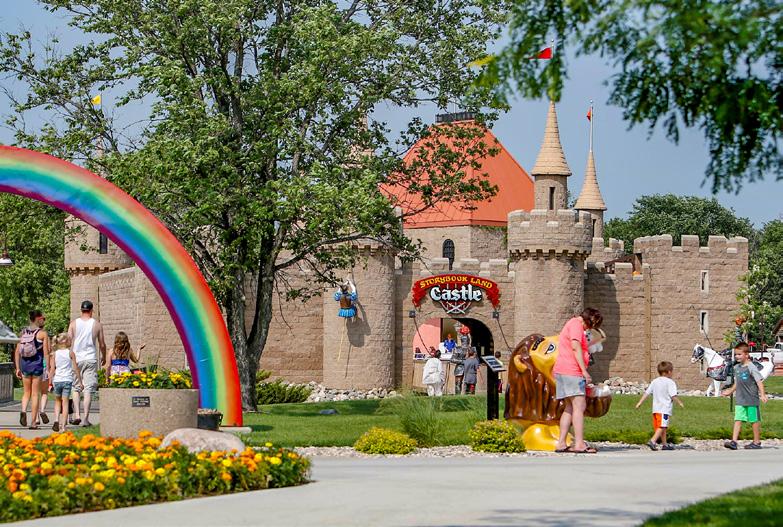
New Softball Fields
Director Doug Johnson says modernizing Aberdeen’s softball facilities is a main priority right now at Parks & Rec. “Our softball facilities don’t really meet today’s standards in terms of field distances and other issues.” The plan is to begin construction on four new softball fields within the next two to three years, and upon completion, have a total of seven new fields open for use in Aberdeen.
Trail Development
has achieved over the years, Doug jokes, “When you’ve been here this long you have to have some accomplishments, or you haven’t done a very good job.” But a few specific things do come to mind, one being Wylie Park. In 1990, voters in Aberdeen approved a 1% sales tax that went directly to Wylie Park improvements. Thanks to that increase, the following year they were able to spend $2 million on major updates to the park. Doug says, “Without that funding source I don’t think we’d have the nice park that we do today.” He also sites the many additions to Storybook Land that have been made over the years, replacing the city’s old pools with the Aquatic Center, moving the ARCC into the old Central High School, and adding 32 miles of public trails as some of the things he is proud to have seen achieved in Aberdeen.
Doug concludes that the most rewarding part of these efforts is getting to build partnerships with other organizations in town, along with seeing families out and about taking advantage of the activities offered by Parks & Rec. “I’ve enjoyed my time here in Aberdeen. It doesn’t seem possible that it’s been this many years.”
Through public meetings and a community assessment survey, the number one request Parks & Rec has received is to further develop Aberdeen’s trail system. This includes adding new trails and connecting current ones to more points of interest in the community, such as schools, parks, and shopping areas. Parks and Rec recently received a grant through the SD Department of Transportation to help fund changes to the trail system’s master plan, and are selecting a consultant to assist with the project. “Within the next six to nine months we’ll be working on updating our trail master plan,” Doug explains.
“WE’VE SEEN SO MANY THINGS ACCOMPLISHED AS A RESULT OF HAVING PATIENCE AND JUST DOING WHATEVER WE CAN TO GET THEM DONE.”
Photos courtesy of Aberdeen Parks and Rec
september/october 2018 ABERDEEN MAGAZINE 37
The many improvements and additions made to Storybook Land over the years are some of the accomplishments Aberdeen Parks & Rec is most proud of.
DID YOU KNOW?
Aberdeen Parks & Rec has five major divisions and 36 full-time employees who, along with their seasonal help, are responsible for a wide list of responsibilities.

Recreation Division
You know those brochures that come out a few times each year that you can’t wait to get your hands on to see what classes and opportunities are happening in town for that season? They come from the recreation division, supervised by Gene Morsching. The recreation division handles programming, activities, and special events for all ages, including the operation of the ARCC, Aquatic Center, Senior Center, and Yapatorium.
Parks Division
Aberdeen has 24 parks that encompass about 600 total acres. The parks division maintains them all, along with taking care of the city’s softball and baseball fields, soccer complex, indoor and outdoor ice arenas in the winter, and Wylie Park. On top of that, they’re also responsible for a mosquito control operation that covers the city limits and Aberdeen’s perimeter, for a total of 99 square miles.
Forestry Division
The forestry division looks after all the trees on the public right of ways in town, including boulevards and park areas. They also administer the Kuhnert Arboretum and the community garden plots. Right now they’re working on a plan to deal with the potential arrival of emerald ash borer, a beetle whose larvae have killed hundreds of millions of ash trees in North America, if and when it arrives in Aberdeen.
Aberdeen Parks & Rec also operates the 18-hole L ee Park Golf Course and oversees Riverside Memorial Cemetery.
Aberdeen’s School for the Arts
David Eckert’s plans to make a living singing in the opera didn’t quite work out the way he thought, but his position as supervisor at the Aberdeen Recreation and Cultural Center turned out to be a better gig. With a voice full of enthusiasm for the facility and its programs, he sums up his 35 plus years with the ARCC by saying, “This has been an amazing place to work. I love this job.”
A Winner native, David first moved to Aberdeen to pursue a degree in music education at NSU. After graduation, he spent the summer using his voice major to sing opera. It was at an opera festival, where he had registered in the pre-professional division, that he started thinking about changing his course. He was the youngest person in his division, and saw a lot of other singers in the their late 20s and 30s who were trying to make it, bringing the term “starving artist” to mind. So he came back to Aberdeen and studied for his master’s degree, and soon discovered that what he really wanted to do was be involved in arts administration. During the last week of finals he started his position at the ARCC. “I told myself I was going to stay at least two years, but not more than five,” he laughs, “but that was over 35 years ago.”
The ARCC provides classes in the visual arts, dance, and music, along with hosting theater and literature events. David describes his role as being like “the principal of an art school.” When he was first hired in May 1983, the ARCC held about 100 classes each year. Today, they organize more than 1,500 activities annually. Their classes reach all ages, from
18 month olds and their caregivers to senior citizens and everyone in between. To give an idea of how many people use the ARCC, in 2016 their records showed 44,000 people signed up for activities, and including their events at Storybook Land, they had a total of 84,000 attendees at their activities that same year.
Currently the ARCC operates out of the former Aberdeen Central High School on Third Avenue SE. This is their third location since opening their doors in 1976, and David acknowledges that acquiring this building in 2004 was a tremendous step that allowed them to grow in to a real community center. They’ve restored some parts of the facility, but as with any older structure, more areas still need improvements and funding these updates can be difficult. David says, “The character of the building is amazing. Even though there’s those challenges, I can’t say enough good things about it and the resource it is in the community.”
“THIS HAS BEEN AN AMAZING PLACE TO WORK. I LOVE THIS JOB.”
Thousands of people use Parks & Rec facilities, like the Aquatic Center, each year.
38 ABERDEEN MAGAZINE september/october 2018
Photos courtesy of Aberdeen Parks and Rec
When the ARCC was just getting started, their predominate focus was on the visual arts, especially pottery. David says that while most classes are cyclical in popularity, their pottery classes are the one activity that has remained consistently wellattended over the years. Right now, their largest program is their dance program. When choosing which classes to offer, they consider a variety of factors, including the availability of equipment, resources, and staff. They’ve hired many music, theater, and art students from NSU over the years as their class instructors, but also have been able to train many of their own. Some kids take a bulk of classes at the facility while growing up, earning the endearing term of “ARCClings.” Those students might eventually get hired in high school as assistants for a class, then go on to teach classes in the summer as college students, and finally, as adults with full-time jobs, continue to teach in the evenings. Some instructors, such as those in their dance program, went through the program as students, advanced on for further training, and are now dance instructors themselves. “We’ve really raised up a lot of our own teachers,” David says.

New Opportunities for Everyone

As the recreation superintendent for Parks & Rec, Gene Morsching says the best part of his job is getting to see area youth trying new activities and finding out they really enjoy something they hadn’t done before. He says, “We get to work with a lot of youth in all kinds of areas, whether that’s through swim lessons, t-ball, tennis lessons, or our Discovery Program. My favorite part is being able to give the kids a chance to explore all these different opportunities.”
Before he started working at Parks & Rec 31 years ago, Gene had a job coaching youth baseball and assisting in legion baseball for a couple of summers while growing up in Huron. He says the parks and recreation director in Huron is who first influenced him to think of his summer job as a possible career. After high school he attended SDSU, but didn’t declare a major right away. “I took a couple of intro to park management classes, and that sort of became the hook that really convinced me to choose this as a profession,” he explains.
Gene’s day-to-day depends on the seasons and which special events are happening throughout the department. Many of these big events, such as the Storybook Land Festival, the Haunted Forest, and Winterfest, have become synonymous with Aberdeen. He says, “We’ve created a lot of relationships with other organizations in town to make these events community-wide, routine activities.” Gene also mentions the growth in the programs for two different age groups in Aberdeen as important achievements. One of these is the series of additions at the Senior Center building. They were able to make the facility larger, and in turn host more activities and grow their number of participants. “The senior board has been a fun group to work with,” he says. The other is the creation of more opportunities for teens through the YAPAtorium and Skate Park. There was a lot of community input asking for these types of facilities, and when the ARCC moved to its current location, they had enough space and were able to secure a full-time person dedicated to a teen center. Before the YAPAtorium opened, they had a committee of parents and students who met and tried to do activities, but not an actual place meant just for them. “We’re glad to have been able to accomplish these things that so many people had expressed an interest in.”
His first job after earning his degree was the director for the Redfield Parks & Rec Department. He says, “Redfield was a good experience because in a small town you get to do pretty much everything.” In 1987, the position for recreation superintendent opened in Aberdeen, and Gene has held the role ever since. “Through the SD Parks and Rec Association I had gotten to know Doug and the other guys in Aberdeen prior to that, and so when the job became available there it seemed like a great opportunity.”
When you think of Parks & Rec, it’s easy to focus on all the participants in their programs, but as a kid who grew up working at a parks and rec department, Gene sees its value from another perspective as well. “One of the things we do for Aberdeen, and a fun part of my job, is the amount of people we employ.” Throughout the year, Parks & Rec hires upwards of 400 seasonal employees. Gene explains, “A lot of people have worked for our department over the years. For many of them we are their first job, and sometimes we’ve had an influence on their career path. That’s a significant thing, to be able to work with the youth who work for us and help them grow, and then see them move on and do some really cool things.” //
“MY FAVORITE PART IS BEING ABLE TO GIVE THE KIDS A CHANCE TO EXPLORE ALL THESE DIFFERENT OPPORTUNITIES.”
The ARCC’s dance program (left) is their largest program, while their pottery classes (right) have been the most consistently well-attended.
september/october 2018 ABERDEEN MAGAZINE 39
Fall Haunts
Located just northeast of Aberdeen, Sica Hollow State Park is full of both eerie stories and autumn colors, making it the perfect destination for a fall road trip
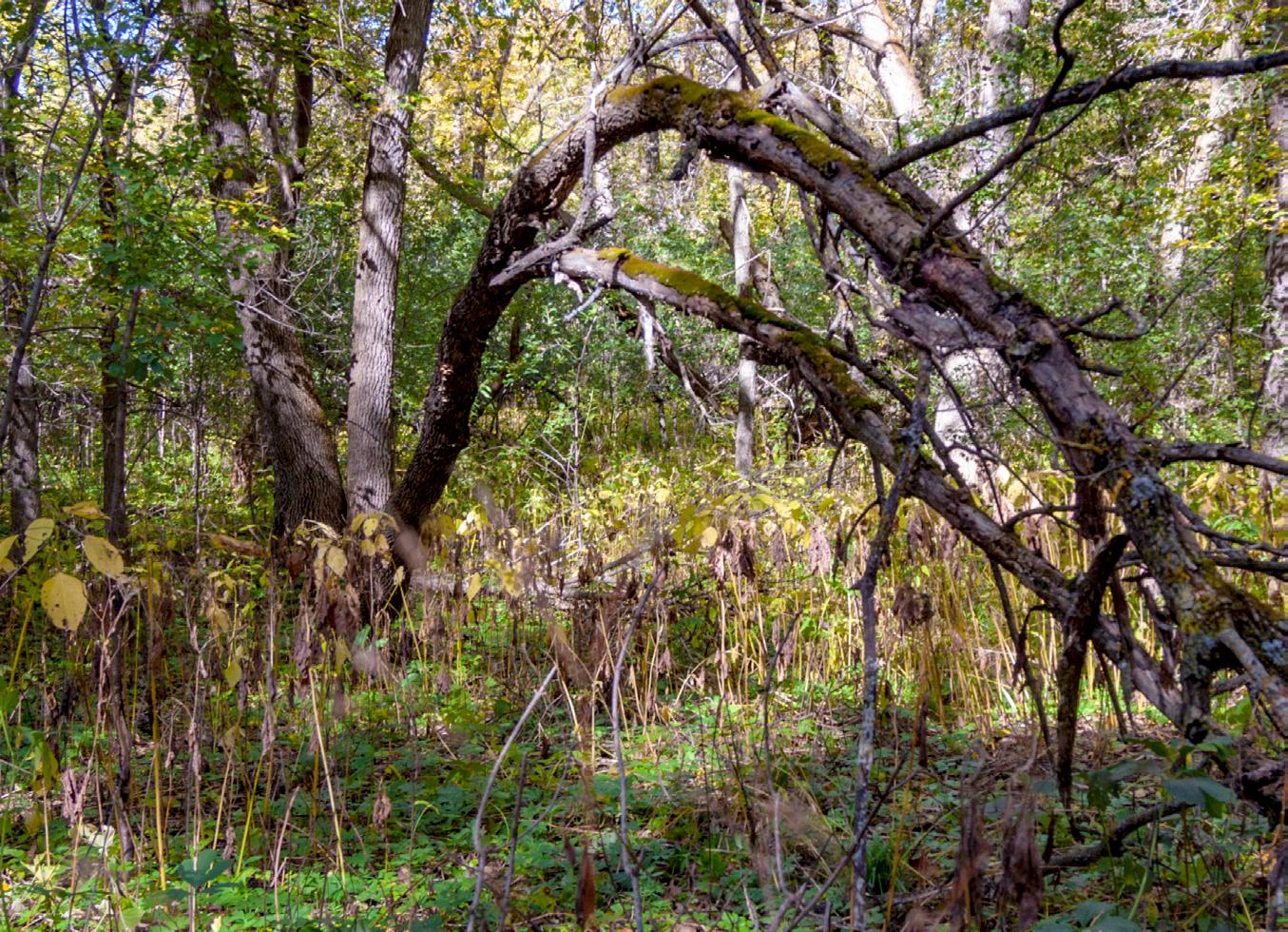 by JENNY ROTH
photos by TROY MCQUILLEN
by JENNY ROTH
photos by TROY MCQUILLEN
f I’m being honest, the first time I visited Sica Hollow State Park I was a little nervous. The park is about a two-hour car ride from my home west of Aberdeen, so the area isn’t part of my everyday stomping grounds, and a quick Internet search to find driving directions filled my screen with accounts of how the area was “haunted” and the scene for “the disappearance of several people in the 1970s.” Further online investigation brought up articles claiming “a Bigfoot-type” creature lives at the park, and that the streams “are red with the blood and flesh of ancestors.” Whoa.
Still, I’m not one to easily believe in ghost stories, so even after reading all this, I packed bug spray, a picnic lunch, and my three children into my vehicle and headed out to see Sica Hollow for myself.
Did we find blood-red water and hear strange noises on our visit? Actually, we did. But is it the stuff of Halloween legends? Or just Mother Nature at work? I’ve talked to people who argue for both ideas, but ever the realist I still vote for the latter, and after falling in love with the park’s beauty, continue to take my family back every year.
Creepy stories aside, if you’re looking for a road trip filled with brilliant fall colors that are close to home,
Sica Hollow can’t be beat. For the best scenic route, I recommend forgetting the Interstate and instead taking US-281 north until it meets Highway 10. Go west on 10, through Britton and Lake City, and turn north again onto the gravel Sica Hollow Road. You’ll go around the park’s Dead Man’s Curve (more about that later) and wind your way to the day use entrance. You can hike on the park’s many horse trails, but the main foot trail is the Trail of the Spirits. At just over one mile in length, it’s
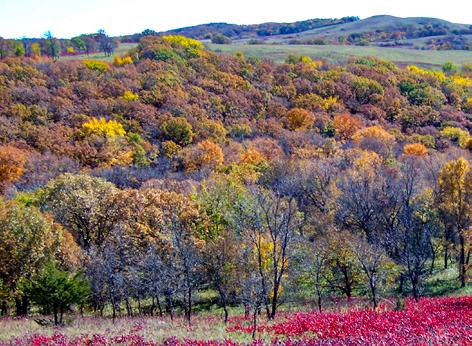
FEATURE
40 ABERDEEN MAGAZINE september/october 2018
an easy walk for all ages. The trail follows Roy Creek, and some of the springs that flow into it, while showcasing many of the 200 plant species that grow here. Since it’s in the low part of the hollow and under a canopy of trees (maples, oaks, ironwoods, elms, and basswoods, among others), the trail is always shady and cool. Once the leaves start to change for the season, it’s also ablaze with orange, red, and yellow hues. The Trail of the Spirits connects to other multi-use trails in the park that go up
and out of the ravine and through prairie grasses for those who want a longer, more challenging route.

And just in case you want a closer look at the spooky, and the science, before you go check out this quick list that separates Sica Hollow myths from the truth.
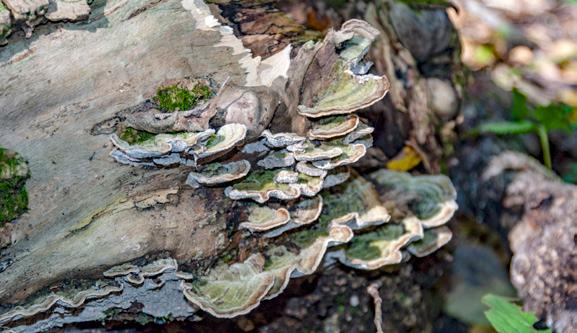
MYTH: People have mysteriously disappeared in the park.
TRUTH: Maybe, though none have been confirmed ghost attacks.
Websites like www.legendsofamerica.com and www.thesiouxempire.com claim that several people went missing in Sica Hollow during the 1970s, bringing fear “to a boiling point” that a strange creature inhabited the area woods, and causing a search party to investigate. After being unable to find
any local news sources with information on missing people in Marshall or Roberts counties from the ‘70s, I decided to call the Sisseton Courier to see if they had any information.
The Courier’s Jennie Evenson grew up near Sica Hollow. She doesn’t remember any disappearances happening in the ‘70s, but says there are quicksand-like bogs in the area that could explain this fear. In the park’s very early days there wasn’t any fencing to keep people on the trails, and if someone went to the park at night and wandered too far and fell into one of these bogs, it could happen that they’d never make it out. “My grandpa owned land east of the park and lost cattle because they got into the bogs and sank in.” These days, there are marked trails and visible fencing on the park’s borders to keep visitors on solid ground.
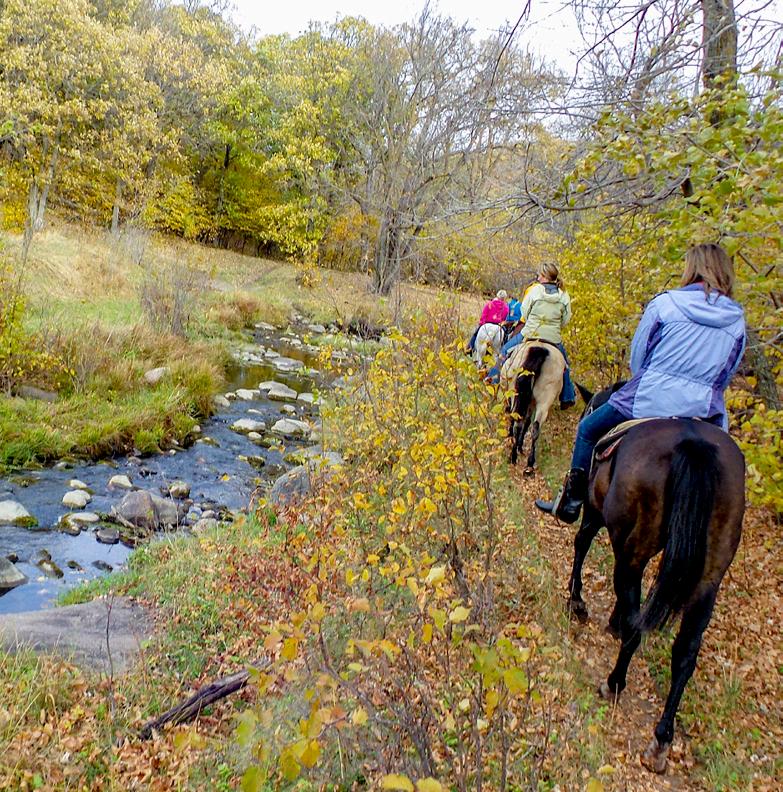
Another explanation for the missing people reports could be the park’s steep drop offs and ravines. Sica Hollow is an unexpected hilly and wooded area surrounded otherwise by prairie and plains, a phenomenon caused by receding glaciers some 20,000 years ago. When you enter the park from Highway 10, you are essentially starting at the highest point and driving down to the lower part of the hollow. Here there are lookout points, like
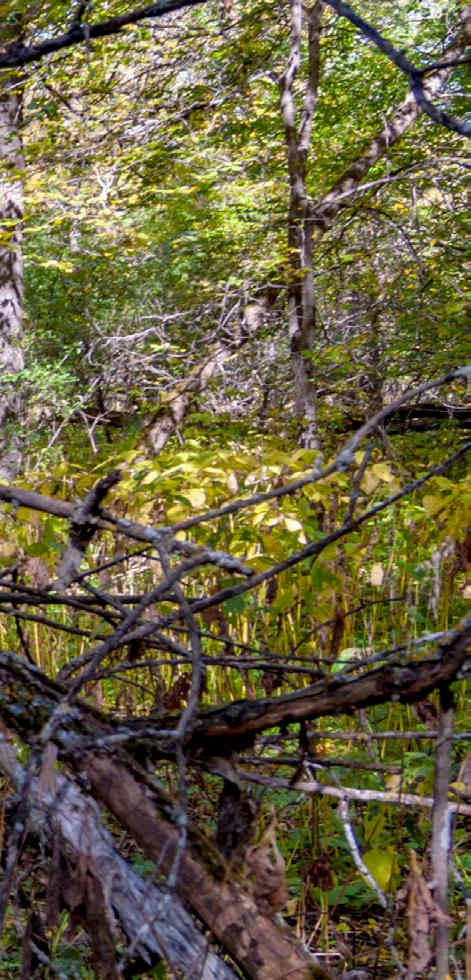
september/october 2018 ABERDEEN MAGAZINE 41
Several springs flow into Roy Creek and follow the park’s main footpath, The Trail of the Spirits.
the one around the turn in the road known as Dead Man’s Curve, where you can park and look down into the tree-filled ravines. Some parts are so deep you can barely see the bottom, and according to Jennie, you can also see “stuff that has been left behind from homes that were there, and cars that have gone over the ravine that they’ve never been able to pull out.”
Myth: Inexplicable sights and sounds occur throughout the park.
Truth: There are some unique happenings at Sica Hollow, but they probably aren’t caused by anything supernatural.
In their book, The South Dakota Road Guide to Haunted Places , authors Chad Lewis and Terry Fisk describe how park officials also use the bogs to explain other strange occurrences at Sica Hollow. The book says, “Moans, groans, and screams heard in the forest are rationalized as sounds of trapped gases escaping from the muddy bogs.” Karen Borgen’s family has owned Canyon Ranch Trail Rides near Sica Hollow since the 1980s. Her husband Art was instrumental in the addition of horse trails to the park. She agrees that “springs in the area are bog-like, and that creates a methane gas that comes up and sometimes glows.” The water at the park can also have a reddish tint, but it’s caused by iron deposits, not blood. Signage along the Trail of the Spirits states, “It is believed that during the winter, air is trapped in the bog which borders the creek. As the snow melts and the ground thaws, the gradually released air makes a sound compared to that made when one blows air over the top of an uncapped bottle.”
Myth: A Bigfoot-type creature lives in the park.
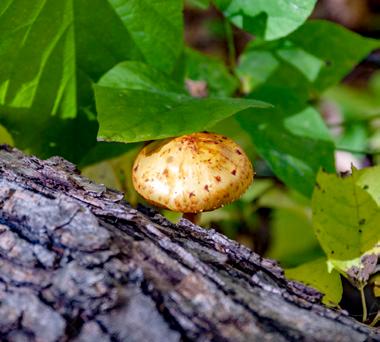
Truth: I’ve never seen one, but there’s plenty of other wildlife in the forest. While the stories I’d heard about an unusual creature living in Sica Hollow described it as being a large, strange bear or something that resembles Bigfoot, Jennie presented another common tale. “Years ago someone found two horse prints instead of four, and it started a rumor of a halfman, half-horse thing.” That’s pretty far-fetched for even the biggest mythical creature enthusiasts, but other animals have definitely passed through the park, including bobcats. “There are deer that live here, so it makes sense that bobcats would hunt here, “ Jennie says. As recently as within the last 10 years, locals have also identified an animal that resembles a small bear (though not confirmed as being a bear) on game cams, but I couldn’t find anything official to identify the animal. In general,
if you visit the park in the daytime, you’ll mostly get to see birds and insects, as well as horses and their riders taking advantage of the horse trails. The woods are noisier at night as more nocturnal animals become active, and Jennie laughs, “When we wanted to be scared to death as kids, we’d go there at night. There’s lots of noises from all the living things in the woods.”
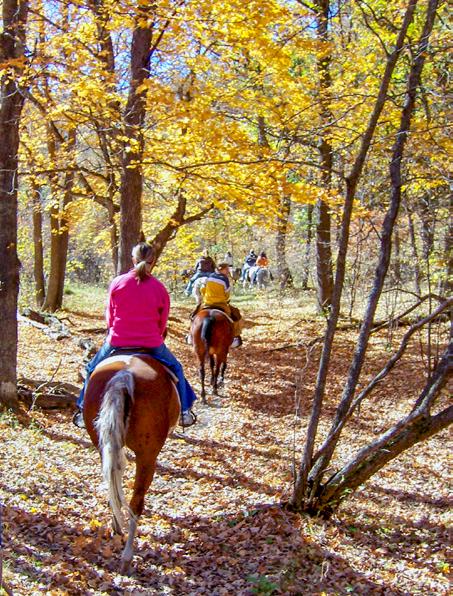
Myth: The park is haunted.
Truth: There is a lot of history and urban legends around Sica Hollow, which can set the scene for a good ghost story.
I’m not out to discredit anyone else’s experiences, or to say that claims of unexplainable drum beats, voices, or disappearing campfires are false. All I can say for sure is that I have never witnessed any of these things in all my trips to the park, but I’ll admit there is an allure of mystery that surrounds the place. “Sica” is said to literally mean “evil” or “bad.” There are a lot of Dakota narratives about the area, and before it was a state park, it was tribal land. Groups of families lived in Sica Hollow for a long time, though these families who did live here have all now either passed away or moved elsewhere.

Sica Hollow State Park,located at 44950 Park Road, Sisseton, South Dakota, is open year round and has eight horse campsites, as well regular non-electrical campsites. Fifteen miles of hiking and horse riding trails weave through the park, and it’s a popular destination for birdwatching and historical interest. For more information, contact Roy Lake State Park at 605-448-5701 or email RoyLake@state.sd.us
One of the first settlers to live in Sica Hollow was a frenchman, Robert Roi, and he and members of his family are buried in the park’s Roy Cemetery, which is over 100 years old. This cemetery, along with another called St. Benedict Cemetery, are near the multi-use trail system at the park.
All of this combined with red bogs, deep ravines, and thick woods is the stuff scary folklore is made of, but to see if any of the myths are really true, you’ll have to experience Sica Hollow for yourself. //
The many varieties of trees at Sica Hollow make a colorful canopy in the fall.
Over 200 species of plants grow throughout the park.
42 ABERDEEN MAGAZINE september/october 2018
Photos by Troy McQuillen
rilliant eautiful B B&

A gorgeous autumn palette brought to you by the Boho Closet Boutique
Why should the changing leaves get all the attention for their show of colors when this season’s styles are just as stunning in their own bold hues? These flowy tops and dresses are anything but ordinary with their deep, earthy shades of yellow, purple, pink, and gray. Add an oversized cardigan or sweater, and you’ll be warm and cozy enough for any fall bonfire. Boho Closet Boutique owner JoAnn Richter describes the looks on these pages as the latest trends combined with comfort and uniqueness. “Everything we do is inspired by a feminine free-spirit,with a little individualistic edge.” //

THE LOOK
photographs by CHRISTINA SHILMAN of PAISLEY TREE PHOTOGRAPHY hair and makeup by AUDRA ARAMPATZIS of AUDRA DAY SPA & SALON
2018 F-150 Raptor from PIERSON FORD Camper provided by DEL and BECKY HARTY
44 ABERDEEN MAGAZINE september/october 2018
Left to right, models Jadyn Brandon, Kati Beadle, and Eden Schanzenbach.
Off the shoulder easy looks, bold florals, jumpsuits, yellow dress with statement sleeves, lavender fedora


Flat profile sunglasses, cozy by Natural Life, boho umbrella, bag with a baja flare

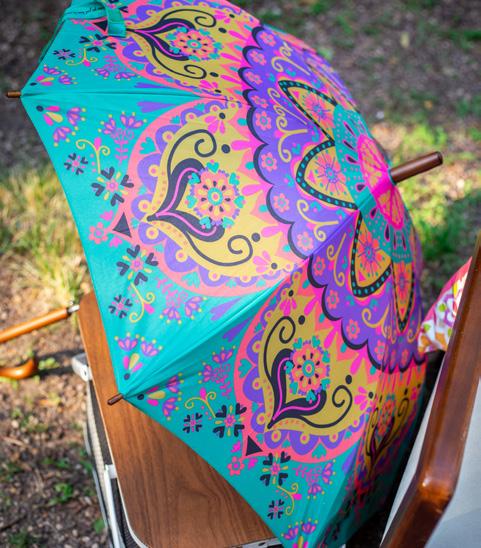

september/october 2018 ABERDEEN MAGAZINE 45
Long and lean maxi in quiet gray, suede sundress, embroidery details






bag in an aztec print, heartland inspired western jewelry, ceylon yellow dress 46 ABERDEEN MAGAZINE september/october 2018
Travel
‘80s distressed denim,fedoras and classic hats, Natural Life bandeaus and handmade bag




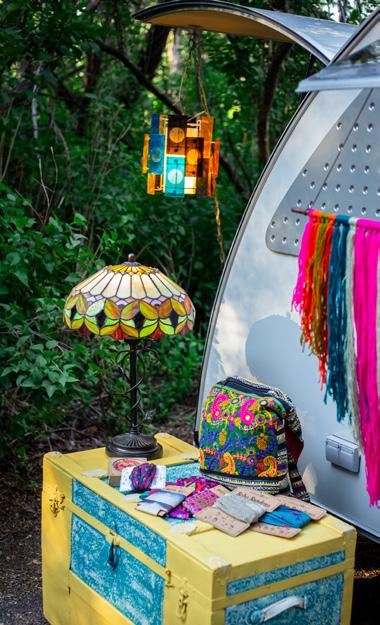 Long leather duster with crop top, one-shoulder slouchy sweater, patchwork shorts
Long leather duster with crop top, one-shoulder slouchy sweater, patchwork shorts
september/october 2018 ABERDEEN MAGAZINE 47
Make or Break
Before a State
Early towns that were established in Brown County and survived
by MIKE MCCAFFERTY photos provided by MIKE WIESE
In past issues, we looked at the city of Columbia, the first “sooner” town in what would become Brown County, and the fate of other sooner towns who gambled on the railroad and lost, quickly fading into history. Aberdeen was established in 1881, and has since grown to be the third largest city in South Dakota. In this story, we’ll learn about other early towns in Brown County that sprang up along the various railroad paths, before South Dakota became a state on November 2, 1889, and still exist today.
(dates refer to the markings on the photos) 1920
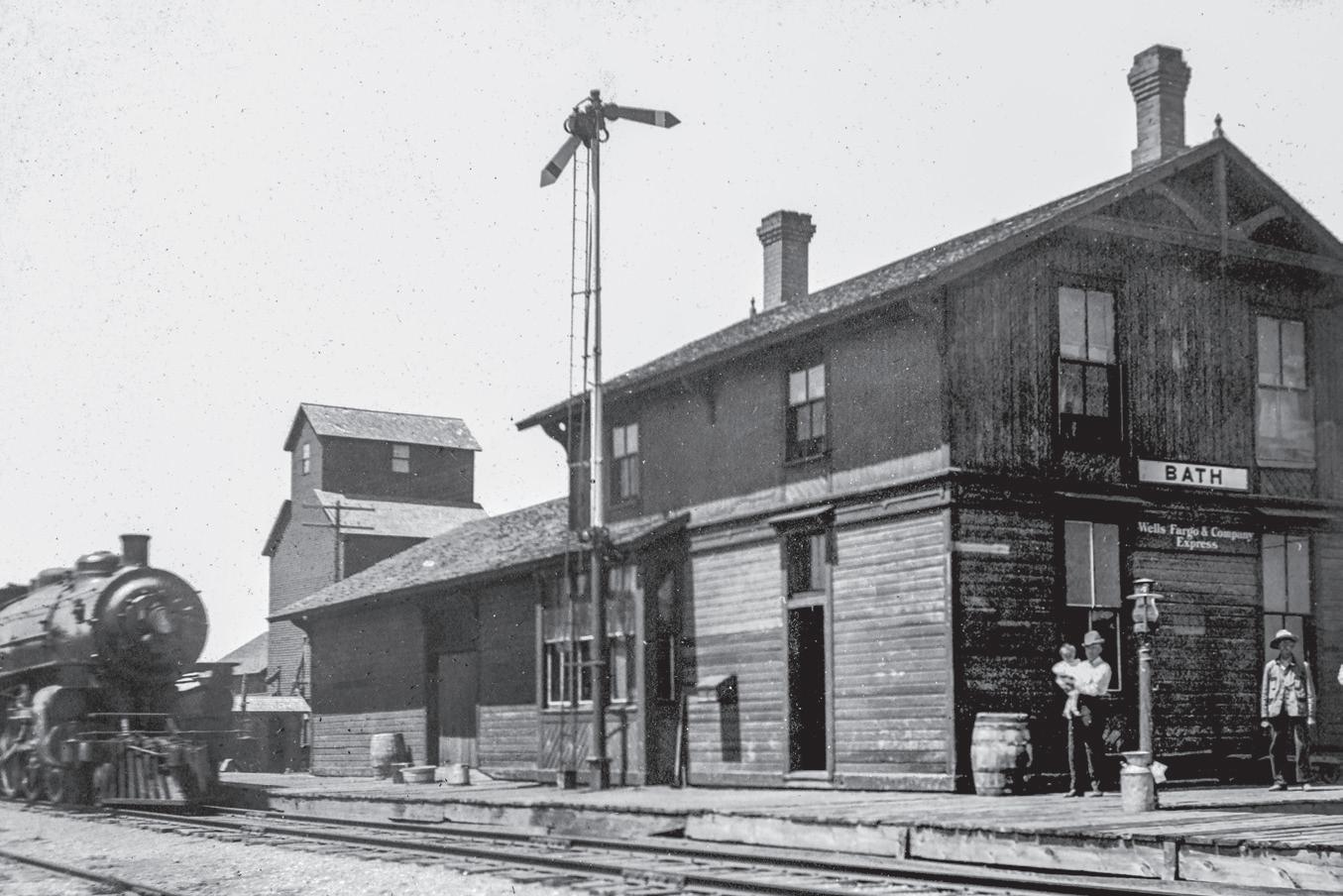
YESTERDAYS
48 ABERDEEN MAGAZINE september/october 2018
➼ At its beginning, Bath was actually bigger than Aberdeen. The train grade reached this site in the fall of 1880, at which time the town was laid out. In May 1881, a post office was commissioned, and by June 1881, the actual rails were laid in Bath. The first building, Raymo’s Hotel, was built two months later. Shortly thereafter, the city boasted two general stores, a bakery, a school, a boarding house, and a depot. A newspaper, the James Valley Post, was published for just that year.
The first wagon bridge was built over the James River and in operation by January 1882. Drought and resulting poor crops from 1883-1886 did affect Bath, but the town survived. By 1886, the city had a third general store, a large livery stable, a doctor’s office, drug and hardware stores, and had added a third story to the hotel. By 1889, it had a blacksmith shop, an elevator, a feed and flour mill, and a lumberyard. Bath had its heyday in the early 1900s. In June 1944, a tornado swept through the community, damaging all but two of the 22 homes. Bath is located six miles east of Aberdeen.
Warner
➼ This site was picked as a townsite on June 28, 1880. A post office was opened on June 9, 1881, and the Milwaukee Road tracks reached the town in the fall of 1881. Again, like Bath, Warner was bigger than Aberdeen for a short time. It rapidly became an economic hub with a depot, bank, two churches, three general stores, two doctors, a school, a butcher shop, barbershop, poolroom, a blacksmith shop, a dressmaker shop, furniture shop and factory, hardware store, a theatre, lumberyard, livery stable, a dray and transfer operation, and four elevators! By 1883, it had begun publishing The Warner Sun, a newspaper that lasted until 1890, when the editor moved to the rapidly growing town of Aberdeen.

Warner managed to survive the drought years of 1883-1886, but ran into tough times. As Aberdeen grew into the “railroad Hub City,” so did it draw people from the surrounding area. A fire around 1913 destroyed the Brown Hotel, Fowler Hotel (where three people perished), the livery stable, a dance hall, the new schoolhouse, an elevator, and many other buildings. The “Dirty Thirties” also took its toll on the town. Today, Warner is a great little community south of Aberdeen.
➼ The land where the town now sits was bought in November 1880 by a man from New England named C.H. Prior, and settlement began. The Milwaukee Road tracks reached the site five months earlier in June 1880. Prior surveyed the town and recorded the plat on July 6, 1881, and a week later the seventh post office in the county was commissioned here on July 13, 1881. By the end of September that year, nine businesses and two newspapers were up and running. Before other rail lines came into the area by the end of 1881, Groton for that very short time was known as the world’s largest shipping point for wheat.
By 1883, the population reached 410 people, and officials were elected to fill a variety of city management positions that included three overseeing trusties. Bonds were sold to drill an artesian well and construct a water system, which they did, but over time they became a liability to the city. In 1885, two three-story buildings were built on the north side of the city by the Presbyterian Church, and were operated as a college known as the “Groton Collegiate.” It closed in 1889, and the classroom buildings, a chapel, and a building used as a dormitory were all moved to Huron.
In 1888, the Groton city government was reorganized into the mayoral style of government. A fire in the early 1900s wiped out a large
section of Main Street, and new brick structures were built in the void. The “great land boom” after 1900 transformed Groton into a boom city overwhelmed by trains. By 1910, the city was a sight to behold. There were, believe it or not, three banks, five insurance agencies, seven elevators, three lumberyards, five grain dealers, four livery stables, four general stores, three grocery stores, four restaurants, two hotels, three blacksmiths, two butcher shops, two newspapers, three farm implement dealers, three harness dealers, two furniture stores, four physicians, two dentists, two druggists, three jewelers, three lawyers, three real estate agents, three draymen, two machinists, three barbers, two theaters, three saloons, two rooming houses, a boarding house, two music teachers, two paint dealers, two contractors, two milliners, two dressmakers, an automobile dealer, an oil dealer, a hardware store, a notary public, a nurse, a novelties store, a feed barn, a cigar factory, a well driller, a veterinarian, a clothing store, a shoe store, a telephone company, a plumber, a cement block factory, and last but not least a photographer! But the hard times of the 1930s took its toll, and many of these businesses closed or combined. Since then, Groton has rebounded and continues to grow slowly. This is a bustling small community 20 miles east of Aberdeen.

Groton
Bath
september/october 2018 ABERDEEN MAGAZINE 49
Mansfield
➼ In 1882, an immigrant from Ireland named John Mansfield platted the town of Mansfield on land he had bought, and sold lots for $25 each. The land straddled two counties, and was first developed on the Brown County side. By 1904, the town had some small homes, two general stores, a depot, a saloon, a blacksmith shop, and a unique elevator built long and low, not high, and powered by a blind horse. That same year, the town expanded into Spink County, and by 1910, it had added three more elevators, a broom factory, and a nursery. The first area telephone company, the Mansfield-ScatterwoodCoop, was headquartered in Mansfield and served a large three-county area until the 1940s, when it was bought out by Northwestern Bell. Many businesses were lost in a fire in 1910, and those that weren’t closed shortly after. This quiet town still exists south of Aberdeen.
Westport
➼ This townsite was platted on June 28, 1880, and the first train from Aberdeen arrived in 1881. On May 22, 1882, a post office was established. The town streets were laid out parallel to the tracks for ease of access, and the community grew rapidly. Despite the drought years of 1883-1886, by 1887 the town boasted a hardware store, a hotel, a confectionery, four general stores, a lumberyard, and a blacksmith shop. The town continued to grow slowly until the 1920s, when due to its close proximity to Aberdeen, it began to steadily decline. Today it still has a small, but dedicated, community population.


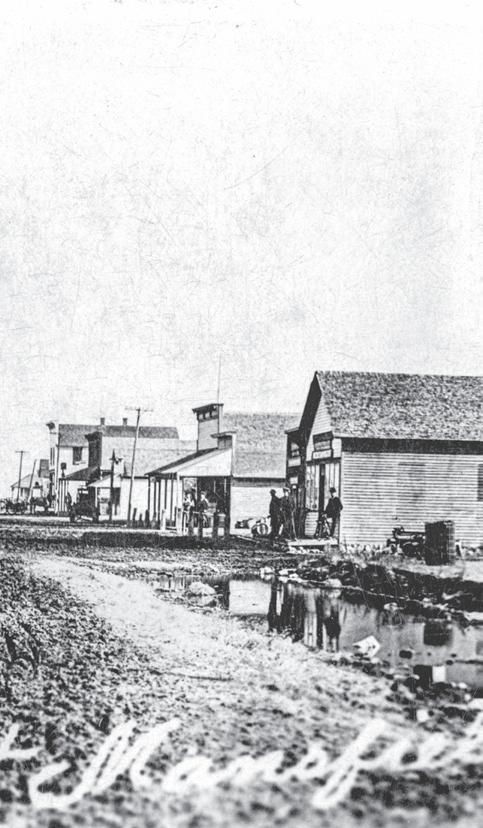

Frederick
➼ When the first Chicago Milwaukee train arrived from Aberdeen on this spot in September 1881, the city of Frederick was staked out. The town was named by the railroad for one of their land agents, Kustaa Frederick Bergstadius, who was from Finland. By January 1882, two buildings were constructed: a shanty home and another that was intended to be a home, but became the town’s first hotel. On March 3, 1882, a post office was opened, and three days later the first newspaper, The Free Press, was distributed. Between March 1882 and the end of that year, a general store with an
upstairs hotel was built. A bank opened. There were 27 buildings that included one barber shop, two saloons, one tailor shop, two attorneys, one general store, four land and loan offices, a blacksmith shop, two lumberyards, three hotels, two hardware stores, and three livery stables. In 1883, two doctors, an attorney, a drugstore, and another hotel came to the community. In 1884, a volunteer fire department was established, as well as a big industrial flour mill that was an important area business for many years. Again, the 1930s took its toll on the city, resulting in a number of businesses closing. The town still goes on north of Aberdeen.
50 ABERDEEN MAGAZINE september/october 2018
1916 1912
➼ In 1881, Cyrus Spurr, a blacksmith from Minnesota, loaded his equipment into a wagon and settled at a spot one mile north of present-day Houghton. He also built a creamery close to the office home of a manager for a stage line that stopped in this area. In 1886, when the rail line reached the spot one mile south and a town was platted, Spurr moved his buildings to this new site and opened the first general store and post office. In 1889, when townships were established, Houghton was split right

down the middle by two townships, Shelby and Lansing. The town soon had a hotel, a depot, lumberyard, bank, drugstore, and a doctor. By the 1920s, there were 19 businesses. Over the years, the famous reporter and author Ernie Pyle visited his relatives who lived one mile east of the community. Teddy Roosevelt came by special train to hunt ducks at Sand Lake, and past SD Governor Ralph Herseth lived a few miles west. Houghton still hosts visitors during hunting seasons.
Claremont

Hecla
➼ The town of Hecla was named by the Chicago and Northwestern Railroad, and was platted on July 2, 1886. This area was well settled by this time, so the town grew quickly. As soon as word of a town leaked out, a depot, and then a restaurant, were built. The city was granted a post office later that year on November 26, 1886. In 1887, a physician moved to Hecla, and along with men of the community, battled a typhoid epidemic that year. The men kept four livery teams available for the doctor to use anytime night or day, and as a result, the doctor lost only two people from over 300 who had contracted the disease.

In 1903, a law office was opened, and in 1904 cement sidewalks eight feet wide were poured along Main Street. In addition, two chemical fire wagons were brought in for the fire department. By 1910, Hecla had two artesian wells in use by the city, and a city electrical company. In September 1922, four businesses were lost to fire, and 14 days later, nine more were also lost to fire. Some of these businesses were not replaced. In the 1960s the largest building in town, the Union Building, and three others burnt to the ground, and in the 1970s the largest elevator was destroyed by fire. Hecla is located northeast of Aberdeen near the north end of the Sand Lake Refuge, and remains active and stable.
➼ Toward the end of 1886, a rail line was built by the St.Paul, Minneapolis, and Manitoba Railroad from North Dakota to Aberdeen. A city named after Claremont, New Hampshire, was established by railroad officials that year. Typical of railroad platted towns, the streets ran parallel to the tracks. The first buildings in town were moved in from Detroit, seven miles northwest, which did not obtain rail connection (see next issue). The first trains actually came through in the spring of 1887.
The town grew rapidly during 1887. They received a post office on
March 19 of that year, and in 1888 the town had a bank, a hotel, two general stores, two lumberyards, a weekly newspaper, two grocery stores, a dry goods store, two hardware stores, a meat market, a restaurant, a livery stable, an insurance office, a drug store, a real estate office, a blacksmith shop, a physician, Dr. Willard E. Densmore, a harness maker, a lawyer, and two implement dealerships. Claremont thrived, but then suffered through the Depression, and like many small communities lost its newspaper, doctor, and many businesses. It is located northeast of Aberdeen.
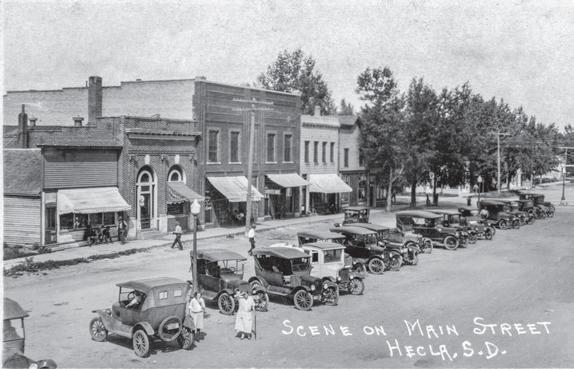
Houghton
1920 1926 1912 51
423 S. Main Street. Aberdeen
605-725-5459 (LILY)




➼ In 1886, the Chicago and Northwestern Railroad laid track between the cities of Doland and Groton, and the city of Verdon was platted. The town was named by a railroad official’s wife who was French. A post office was established on June 14, 1887, and by 1888 the city had four general stores, two livery stables, a real estate office, a hotel, a confectionery, a restaurant, a meat market, a harness maker’s shop, and a newspaper, The Verdon Times. When Verdon reached its peak in growth, the town had five elevators and 26 other businesses. The town’s demise started in 1906 when it declined to make a bonus payment to the Minneapolis and St.Louis Railroad for putting an east-west line through town. The track was then run west through Conde, south of Verdon. Verdon is most famous for its opera house. It was built in 1916 by area residents buying stocks in it for $25 per share. It is no longer there. Verdon is south of Groton.

➼ Ferney was platted on October 30, 1886, a few months after Verdon, and its name is also French, having been named by the same woman who named Verdon. The trains started running in the spring of 1887, and a post office was established in a new general store in August of that year. Ferney grew slowly, and by 1900 had a bank, a flour and feed mill, two barber shops, two contracting firms, a poolroom, a blacksmith shop, a dray line, three elevators, two general stores, a hotel, a hardware store, a meat market, a harness dealer, a livery stable, a restaurant, a real estate office, and two saloons. The town was always known as a “liquor/party town” for it, along with the town of James (see next issue), were the last two places to close during the prohibition years, and the first two to reopen. Apparently they had a statewide option for towns to be dry by community vote, so when the surrounding towns all voted to be dry, Ferney stayed “wet” and the Ferney saloons were thriving with business. As a result, the Ferney jail was also very busy during these years of prohibition, especially during the summer months, when transients from all over would flock there to drink and have a good time.


Home mortgage financing with great options. Ona Hughes Mortgage Loan Originator ona.hughes@usbank.com 605.226.4140 NMLS #: 1114399 Equal Housing Lender. Loan approval subject to credit approval and program guidelines. Interest rates and program terms are subject to change without notice. Some restrictions may apply. Mortgage and Home Equity products offered by U.S. Bank National Association. Member FDIC. ©2017 U.S. Bank 160036 11/17 Stay tuned for our next issue, where we’ll discuss the towns in Brown County that came to be after 1889. Some are still going today, while some are gone forever. //
WELCOME
BACK
Located in historical downtown Aberdeen 725-CLAY HAVE YOU SEEN OUR GRANDMA CHRISTMAS TREES? COME PAINT YOURS TODAY AT COLORFUL CREATIONS! Join a party or walk in anytime. See our website calendar or give us a call for more details. Stop in today! 207 S Main | Downtown Aberdeen www.thecolorfulcreations.com
52 ABERDEEN MAGAZINE september/october 2018
Verdon Ferney
LIVING IN THE PAST
Mark and Cherie Shishnia Discovered a Hidden Piece of Hub City History Inside Their Home
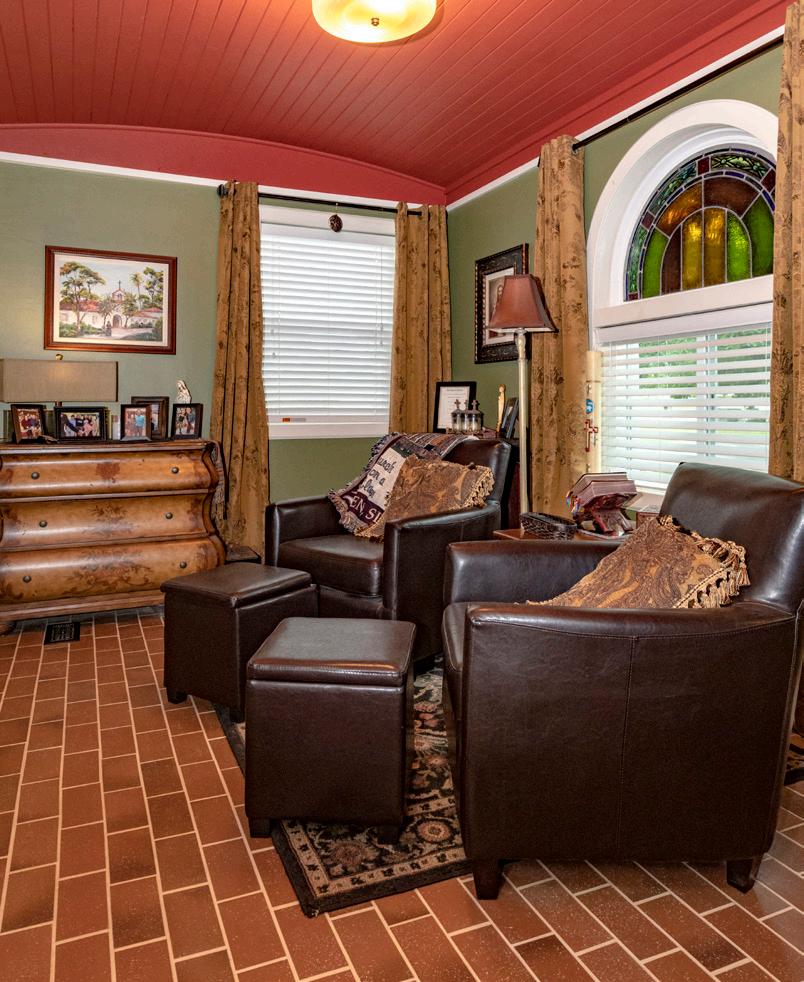
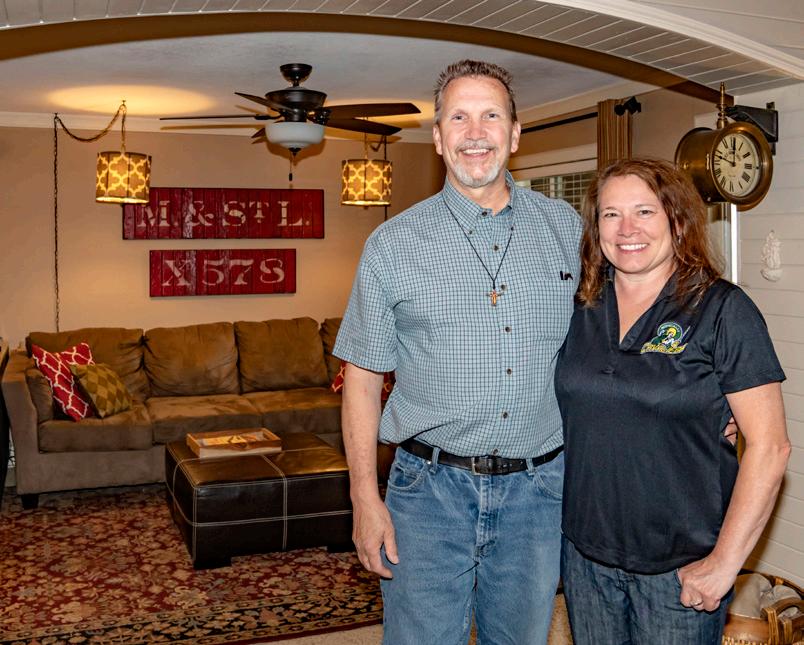 by TROY MCQUILLEN
by TROY MCQUILLEN
TYou may have seen images or TV shows about people making modern-day homes from corrugated shipping containers.
Aberdeen has an equivalent home, but you’d never know it. And while it isn’t quite a shipping container, it is a 100-yearold boxcar, or freight car, from the railroad.
Imagine cutting a hole in the wall of your living room for a remodel project and discovering “fossils” of an old train boxcar. Many questions would arise for sure. Mark and Cherie Shishnia had heard from one of their neighbors on North Penn Street that there was a “boxcar” inside their house. In fact, the previous owner was worried that future owners would be disappointed to learn this fact. However, the Shishnias were overjoyed at the history, and interior design potential, of having a real-life railroad boxcar as part of their house.
Unfortunately, if you drive by their house thinking you’re going to see a boxcar stuck to the side of the home, you’re mistaken. It is seamlessly integrated. In fact, when they remodeled their home and added an extension, they revealed the end of the boxcar behind the siding. Their home was perfectly fused to the boxcar.
As part of an addition remodel, the Shishnias planned to cut a big hole in an interior wall to open up another room, which they affectionately call a chapel. Mark was surprised at how difficult it was to cut through the wall. Normally one would just cut through drywall or plaster, then slice studs off. The boxcar was not built like that, as you might imagine. There was a steel frame covered on both sides with yellow pine wood “car siding.” The process taxed his tools and destroyed saw blade after saw blade. But eventually he cut through, and when the
The Shishnias remodeled the front portion of a boxcar discovered in their home to serve as a sitting room or chapel, complete with a stained glass window.
Mark and Cherie Shishnia framed the railway company’s original markings painted on a portion of the boxcar wall left over from when they cut a hole in their living room.
OPEN HOUSE 54 ABERDEEN MAGAZINE september/october 2018
wall section dropped down, the original color and railroad company markings were revealed on the removed chunk. It was evident that the car belonged to the Minneapolis & St. Louis Railway Company, whose depot building still stands on South Main, restored by CO-OP Architecture.
The Shishnias salvaged as much of the brightly painted red car siding pieces as they could, as well as the sections with lettering, and used them in various aspects of their home. Mark had to restore the lettering a bit to even out the white graphics. These sections are now proudly featured in their living room. The boxcar addition to the

home includes their chapel, a bathroom, and the laundry room. An arched ceiling in all three rooms is a reminder of the car’s shape.

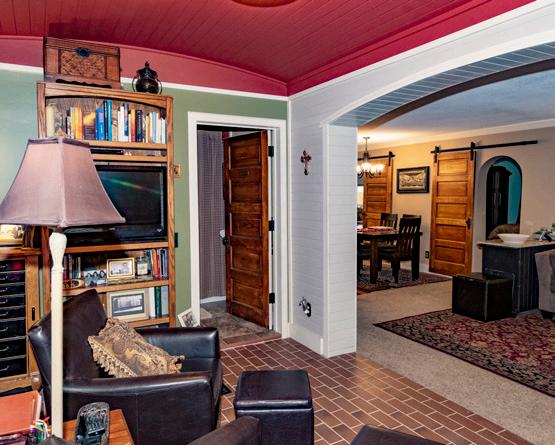
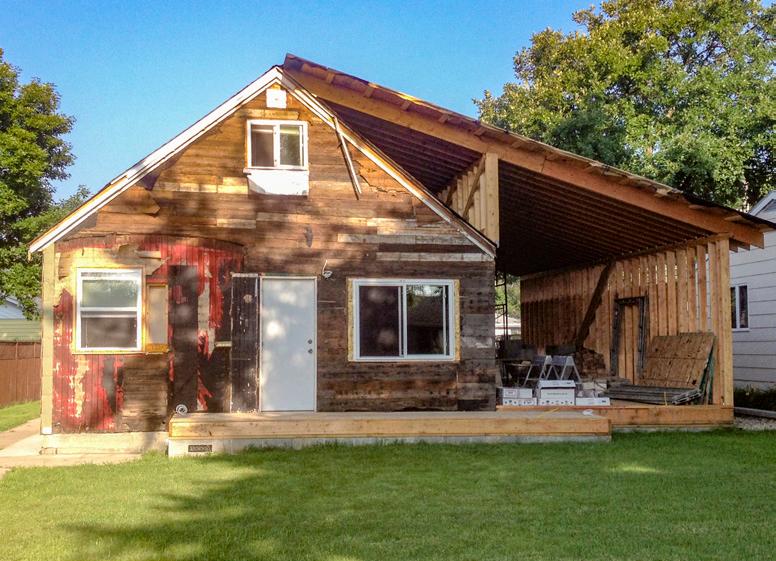
According to Mark, the boxcar is nine feet wide by 37 feet long. The wheels were removed, and the car was positioned on a foundation. He states that the earliest use of his property and boxcar may have been a tractor repair shop years ago. The previous owner, Everett Smith, says when he purchased the home in 1960 the box car was already converted into a house. At that time he did some remodeling which included removing sleeping bunks from


the boxcar part of the house. Apparently, the railroads switched from wood boxcars to steel versions after WWII and sold off or gave away surplus or unwanted wood cars.
The Shishnias are very proud to live in a house with a piece of history so connected to Aberdeen’s past. Mark tells nostalgic stories of growing up near the tracks, so the railroads have a definite place in his heart and home. Cherie's dad worked at the Lux Candle Company in Ipswich. It too, is a boxcar. //
This is a picture of the same type of boxcar similar to the one embedded in the Shishnia’s home on North Penn Street.
Mark and Cherie were very suprised when the cut-out section fell, revealing the railway company markings.
The box car is divided into three areas, the chapel, shown here, a bathroom and a laundry room
A portion of the bright red car siding of the boxcar is still revealed in the stairwell into the basement.
When the siding was removed for the remodel, the end of the boxcar was very evident.
They’ve tried to salvage as much of the wood as they can for decorative enhancements throughout their home.
september/october 2018 ABERDEEN MAGAZINE 55
Photos by Troy McQuillen and Mark and Cherie Shishnia
FITNESS GOALS? THERE’S AN APP FOR THAT!

A BEGINNER’S GUIDE TO FITNESS APPS
Spend less time researching apps, and more time using them, by downloading some of these fivestar, user-friendly options.
Track your workouts and food
by ERIN COATS
Erin Coats, wellness coordinator at the Aberdeen YMCA, explains how technology can be used to your advantage when it comes to living a healthy lifestyle
In this beautiful life we’re given, we only get one body, and it’s up to us to make choices that help it perform as efficiently as possible.
But we all have our busy, hectic schedules, and healthy living can easily fall by the wayside when our to-do list fills up. Fitness is not only about fitting into a certain size, or having a specific shaped physique, but also about being able to perform functional movements with ease, and having ample energy to keep up with our day-to-day activities.
The only problem with fitness in this fast-paced world we live in is that there’s no one-time solution or quick fix to get there. Most things we desire nowadays are available on demand, as evident in the lines at the drive-thrus and the multitude of prepackaged and ready-to-eat options at the store. So, there’s got to be a shortcut for fitness
too, right? Wrong. The only way to reach fitness and nutrition goals is with consistent, daily effort. That’s not to say there’s never a cheat day, cheat meal, or time to lounge and relax. And the good news is that there’s a way to connect our love of technology with healthy living. Whatever the need, there’s an app for that!
The first place to start is with your calendar app. Schedule your workout time. If you need to, add a second time option if there is a chance the first time may not work. Have a plan. If you’re training with a group or with a personal trainer, it’s taken care of for you. If you’re flying solo, plan a workout ahead of time, so that when it’s time to get it done you just need to do the work.
There are plenty of apps that have prewritten workouts, or depending on the gym or equipment you are using,
there are preprogrammed workouts available to follow. If you’re training outdoors, there are apps that can track your route through GPS to tell you your distance travelled, your pace, and how many calories you burned. If you’ve reached the end of your day, and despite your best efforts, you didn’t get to the gym or get outside to walk or run, don’t fret or give up, there’s an app for that too! There are several apps that have no equipment needed exercises that you can perform in your living room while you’re catching up on your favorite TV show.
Try out a fitness and nutrition app that has you input your food and drink, as well as your activity, for the day. When you set up the app, you will put in the goal that you’re working toward. After inputting each day’s info, the app will tell you whether your current intake and energy exertion are progressing toward your goal, or whether you are going to stay the same. Right there, black and white, no excuses made. This can be a great way to hold yourself accountable if used properly and honestly. For a little added motivation, invest in personal nutrition counseling or personal training, and leave some of the planning to the experts.
The only guarantee in your fitness journey is that hard work and consistency are the biggest keys to your success. You won’t get there in a day, a week, or even a month, but being prepared and being consistent will make that one body you’re given equipped to carry you for a long time. So, try out some apps and find ones that work for you! Pack your workout bag the night before, prep your healthy food choices ahead of time, and get it done. The best investment you can make is the time and effort spent to be your best self- mind, body, and spirit. //
y MyFitnessPal
Improve your 1RM
y One Rep Max Calculator
Train for a race
y Couch to 5K
Get HIIT and group fitness workouts while sharing with a community




y ACTIVEx

Exercise videos
y Sworkit
Track your miles, pace, and time of your walk or run
y Runkeeper



y Moves
y Strava
y Runtastic

Scan your items at the grocery store to learn their nutritional value, or select a category to get a list of the healthiest options
y Fooducate
Learn more poses and do yoga anywhere
y Pocket Yoga

Meditation
y HeadSpace
y Meditation Studio
Bodybuilding
y JEFIT
Music
y Fit Radio
Record the workouts you’re doing on your own
y FitNotes
Over 200 exercises that require no equipment. Perfect for beginners, or if you are unable to make it to the gym that day
y You Are Your Own Gym
IN THE BACK
Illustration by Eliot Lucas
56 ABERDEEN MAGAZINE september/october 2018



















 Elizabeth Wachs
Elizabeth Wachs
















 by TARA SCHIPKE
by TARA SCHIPKE



 by JENNY ROTH
by JENNY ROTH








 by JENNY ROTH
by JENNY ROTH






 by JENNY
by JENNY

















 Ben Root is the first Aberdeen sportscaster to win the National Sports Media Association’s Sportscaster of the Year Award.
Ben Root is the first Aberdeen sportscaster to win the National Sports Media Association’s Sportscaster of the Year Award.










 by JENNY ROTH
photos by TROY MCQUILLEN
by JENNY ROTH
photos by TROY MCQUILLEN

























 Long leather duster with crop top, one-shoulder slouchy sweater, patchwork shorts
Long leather duster with crop top, one-shoulder slouchy sweater, patchwork shorts


















 by TROY MCQUILLEN
by TROY MCQUILLEN
















